Method For Preparing Transfructosylated Steviol Glycoside Using Microorganism Of Genus Arthrobacter
Yang; Tae Joo ; et al.
U.S. patent application number 16/759437 was filed with the patent office on 2020-09-17 for method for preparing transfructosylated steviol glycoside using microorganism of genus arthrobacter. This patent application is currently assigned to CJ Cheiljedang Corporation. The applicant listed for this patent is CJ Cheiljedang Corporation. Invention is credited to Eun Jung Choi, Sun Chu, In Sung Kang, Min Hoe Kim, Seong Bo Kim, Young Mi Lee, Young Su Lee, Sunghee Park, Tae Joo Yang.
| Application Number | 20200291443 16/759437 |
| Document ID | / |
| Family ID | 1000004883670 |
| Filed Date | 2020-09-17 |
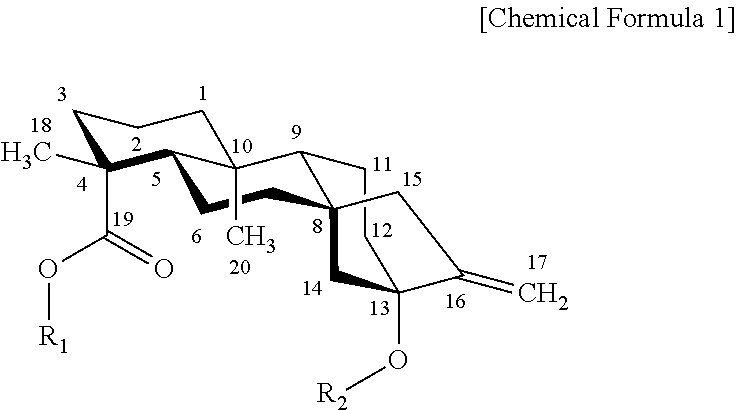
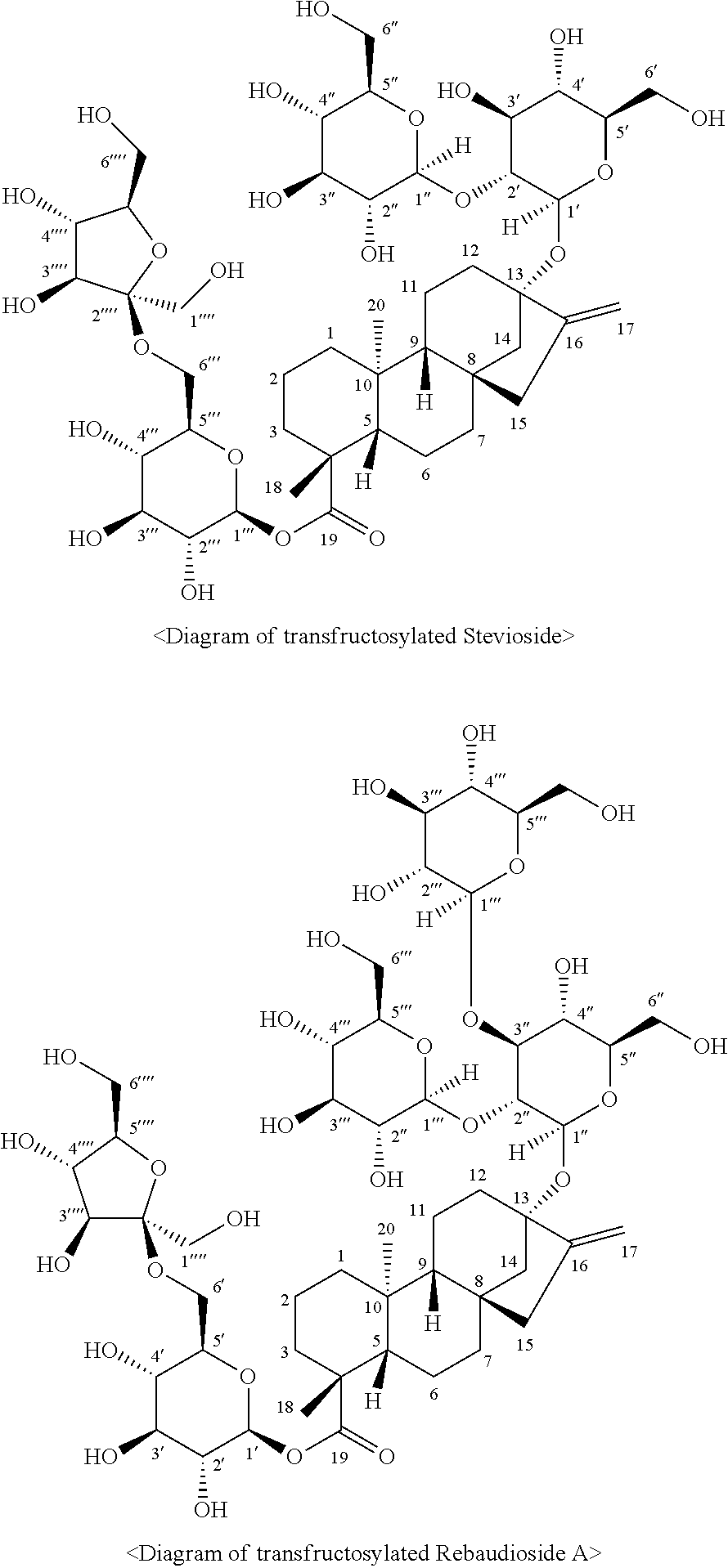
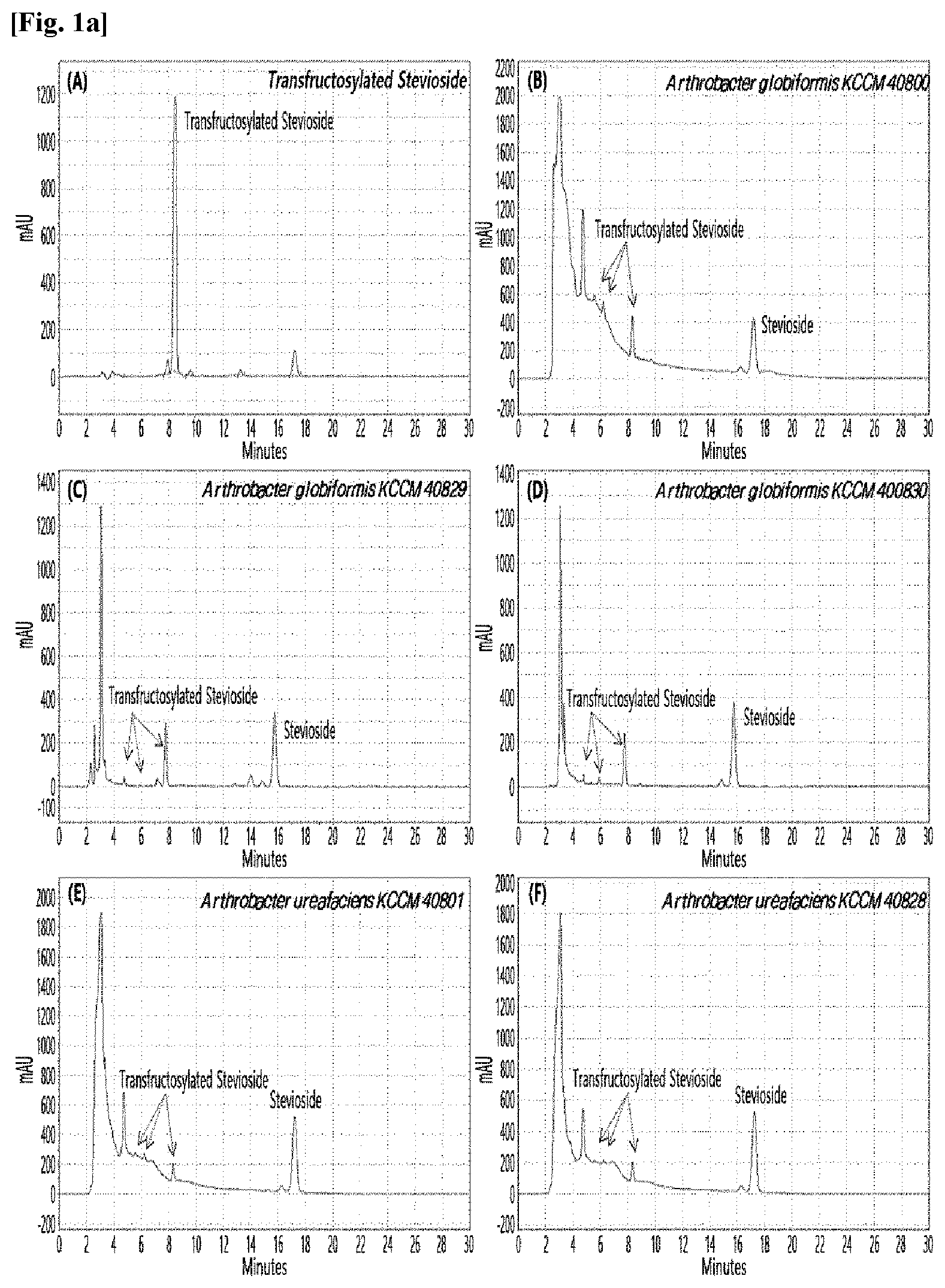
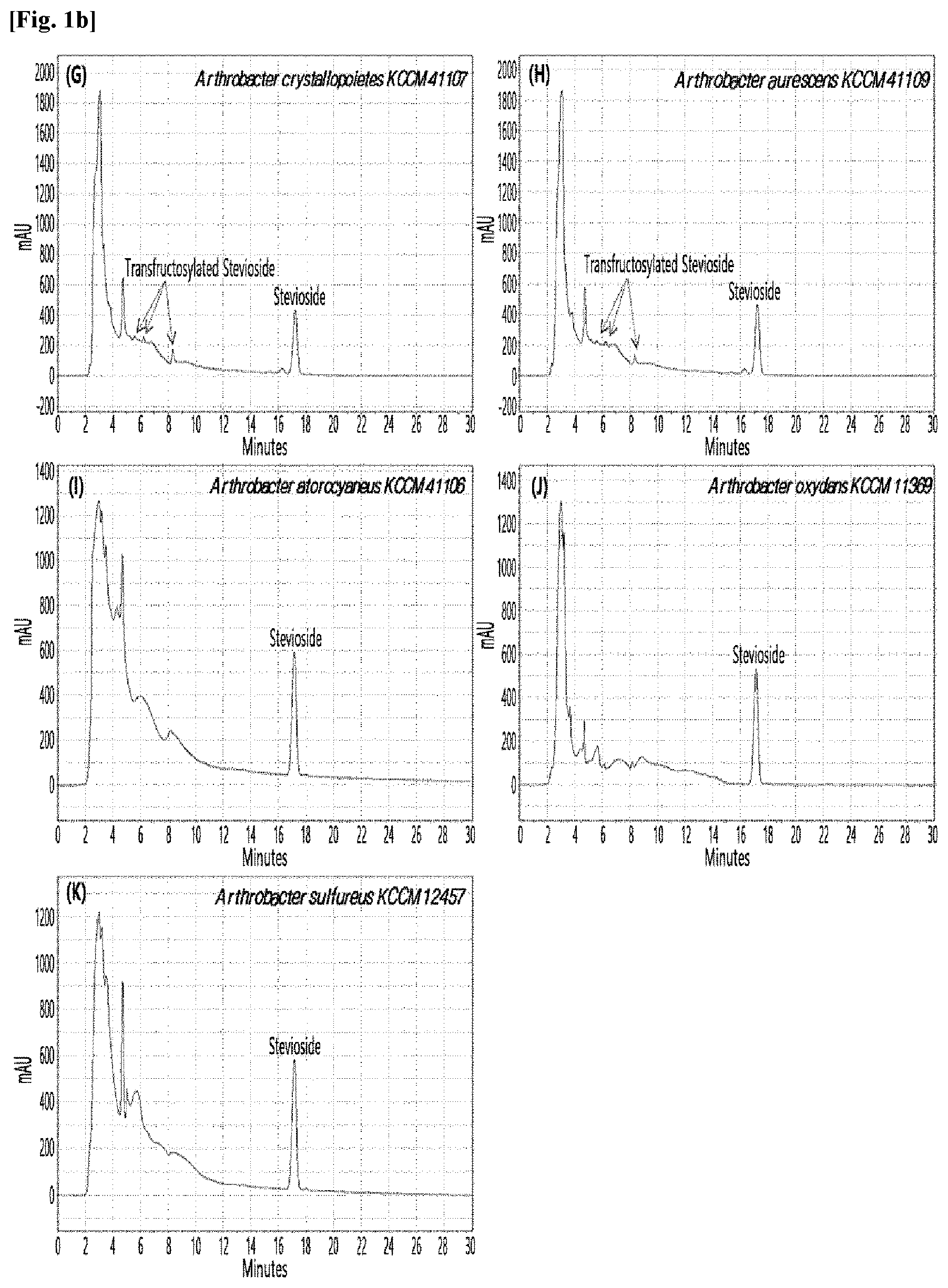
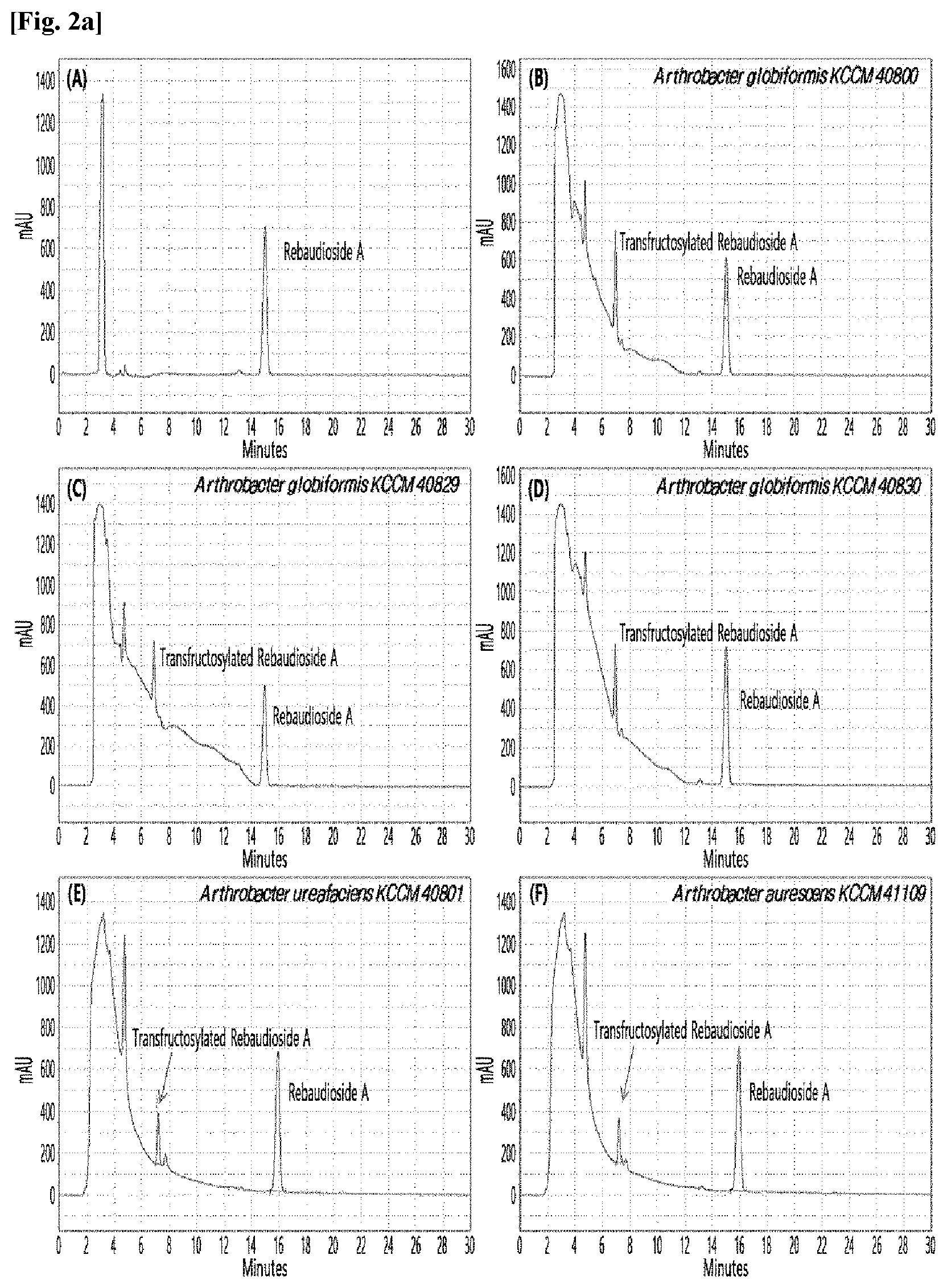
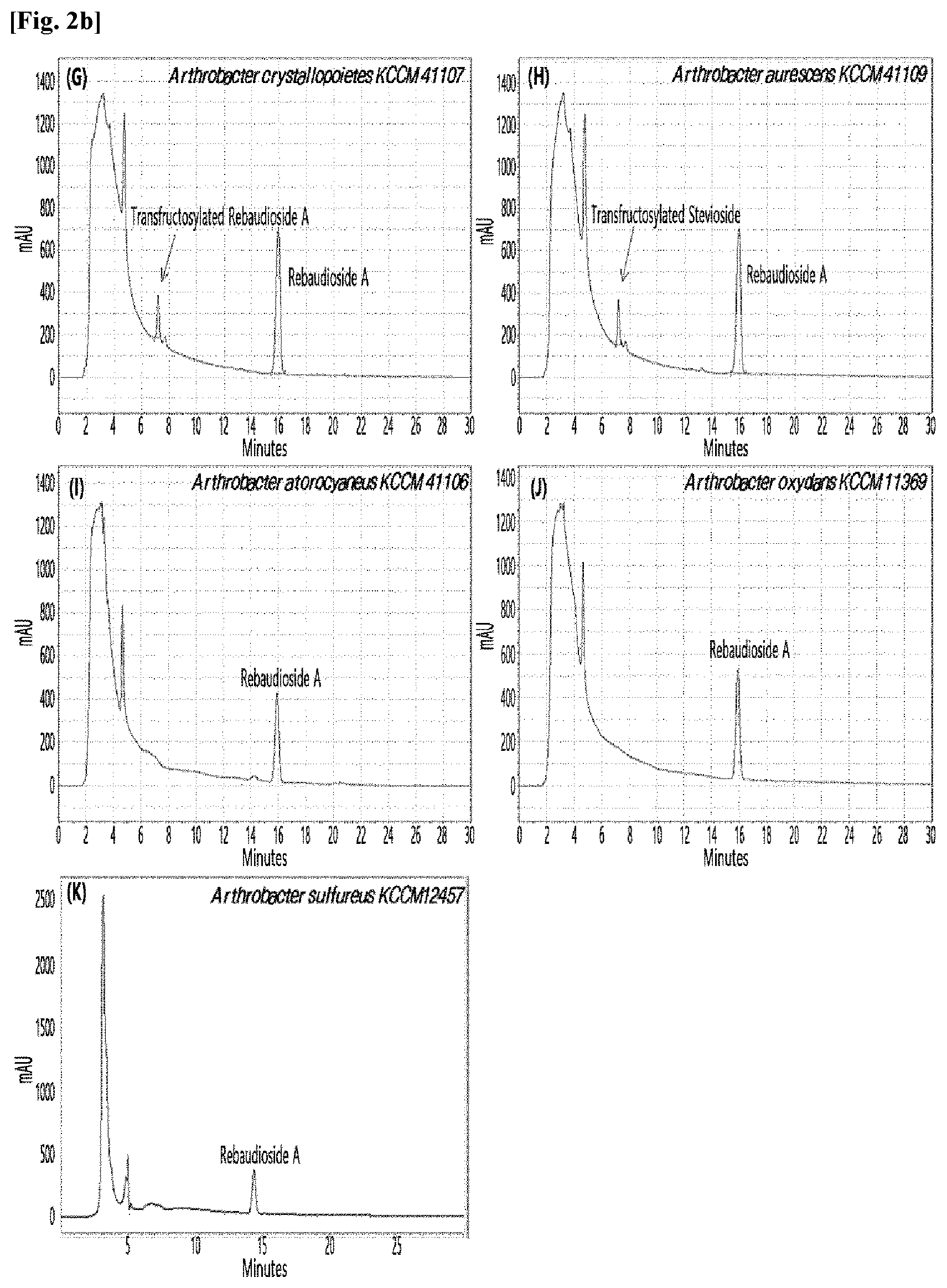
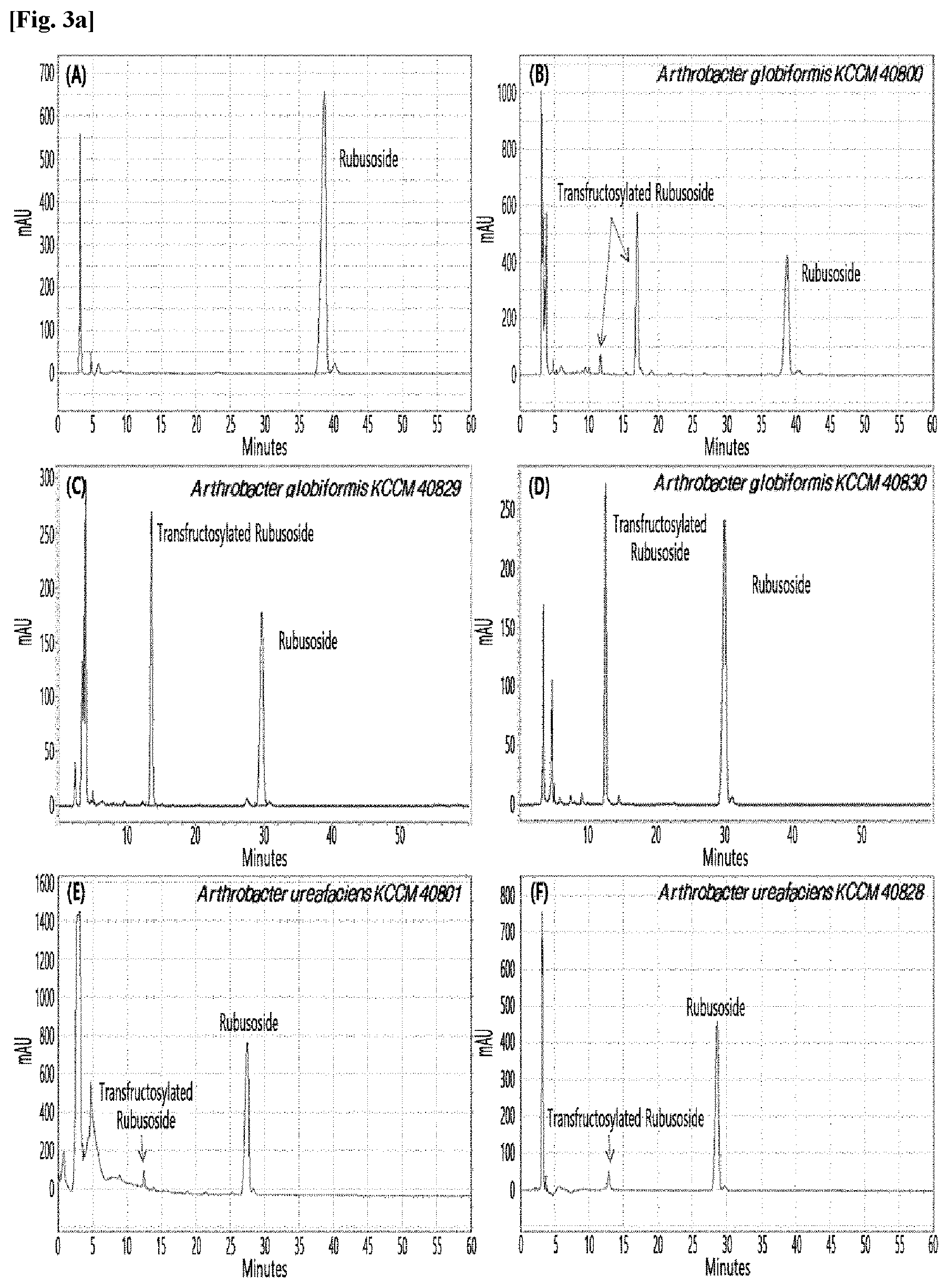
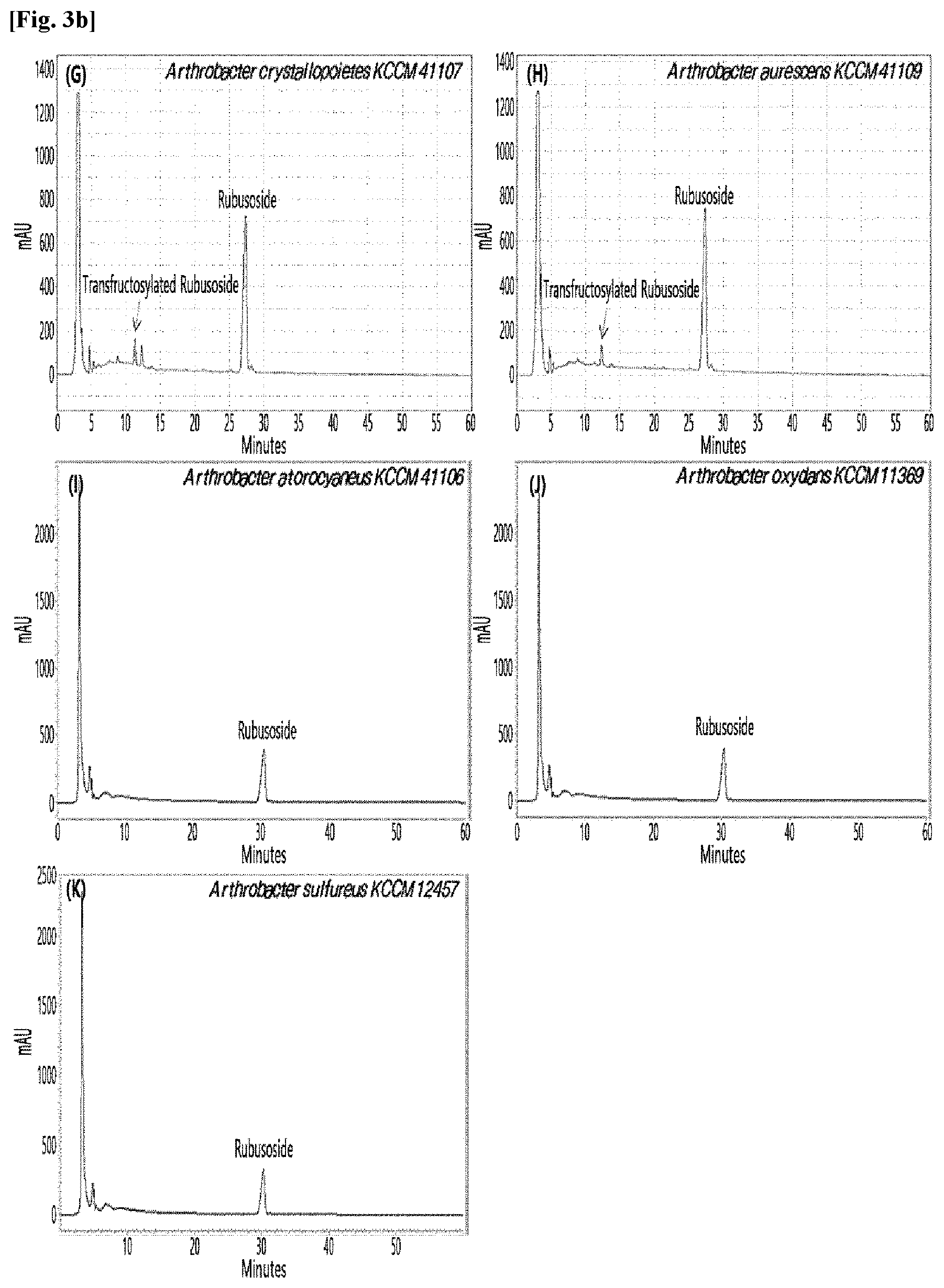
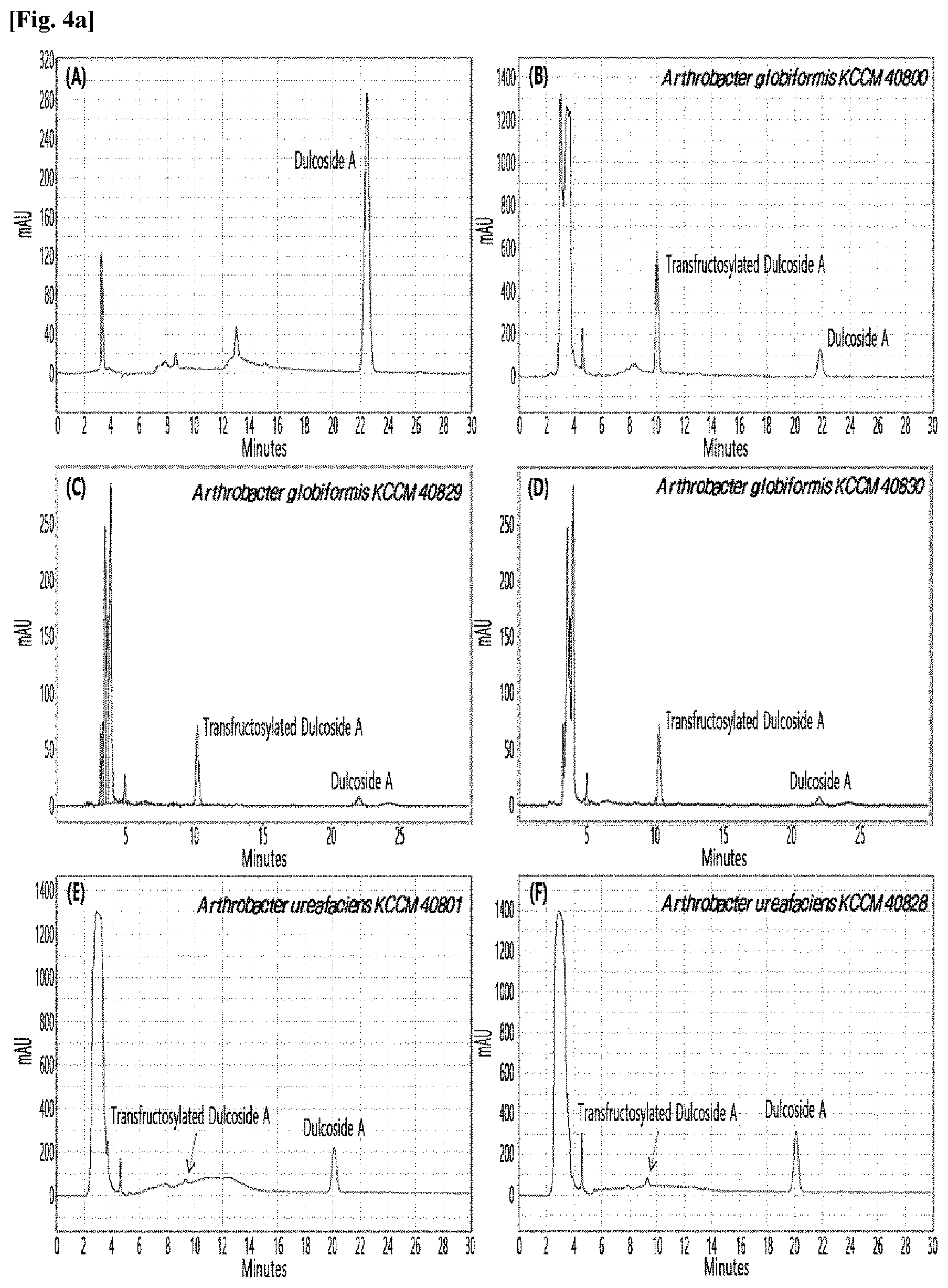
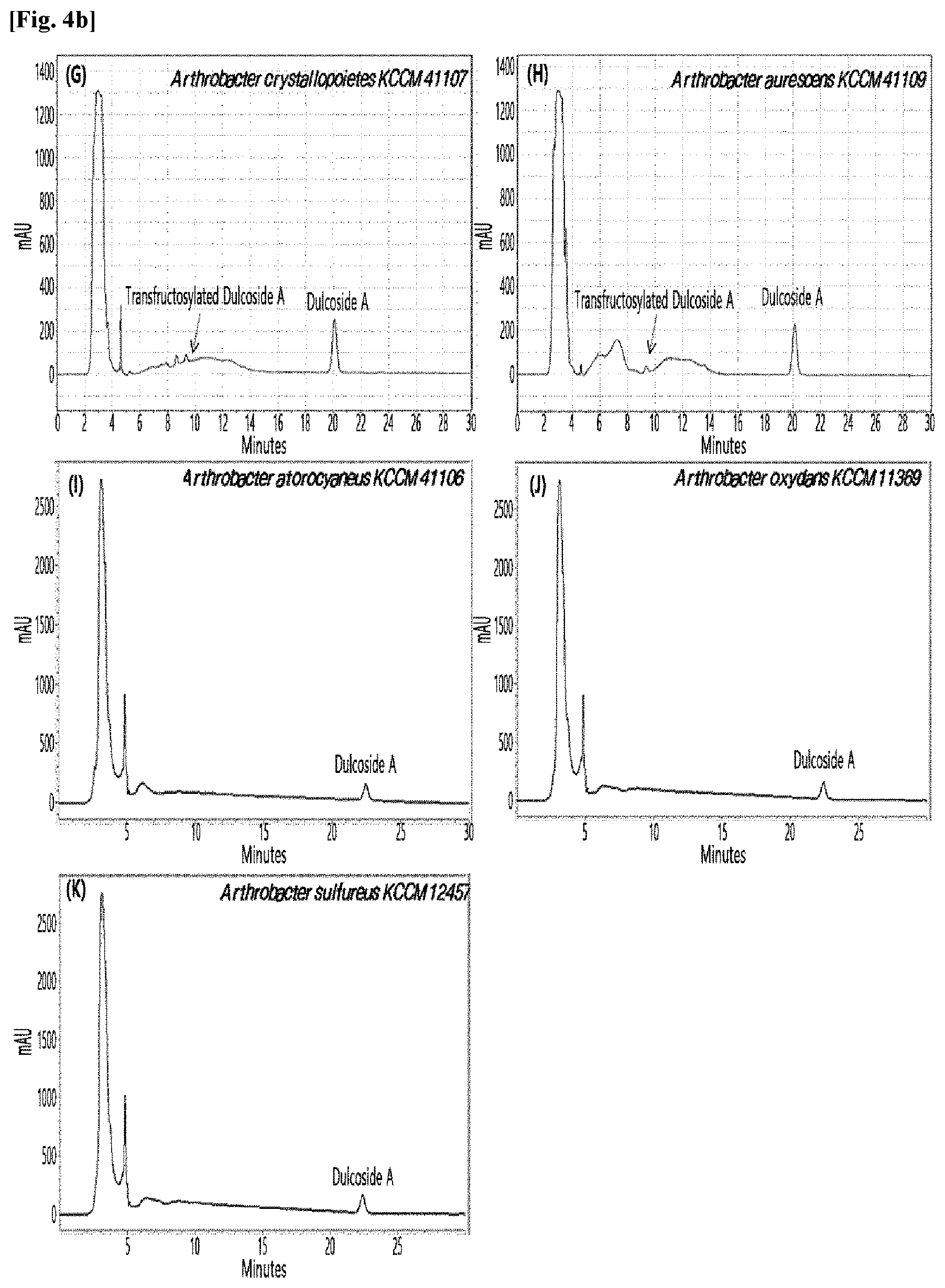
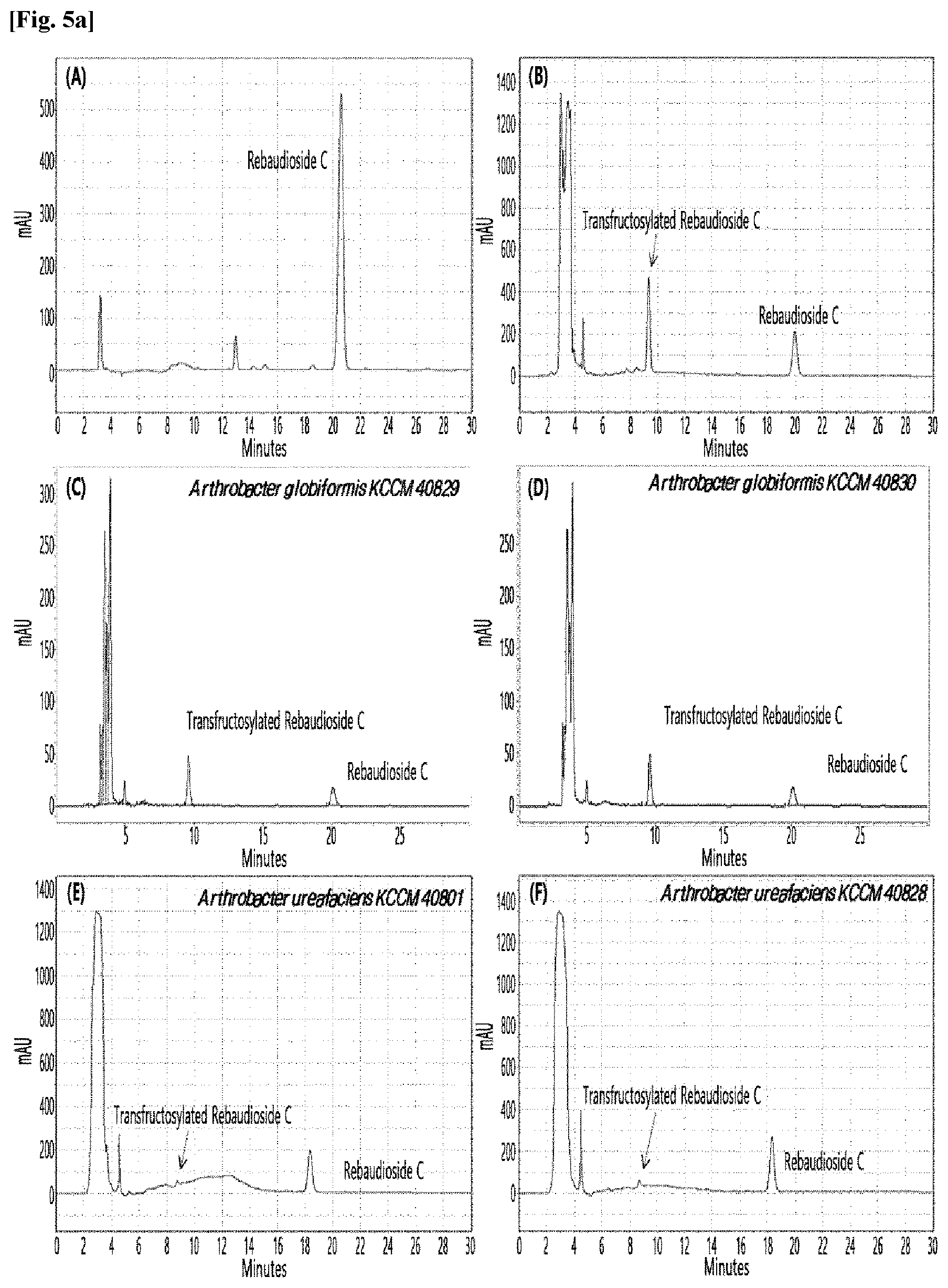
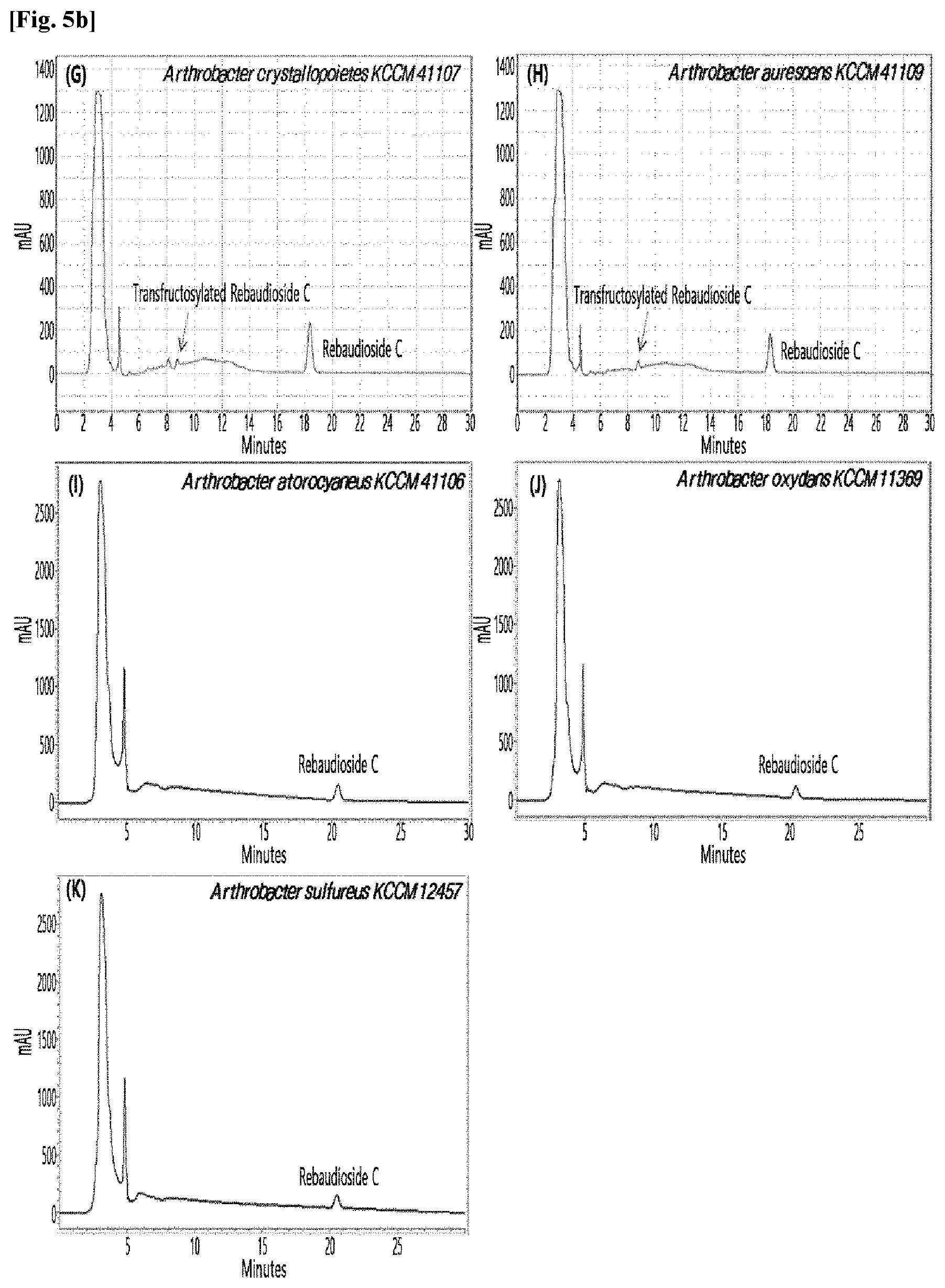
View All Diagrams
| United States Patent Application | 20200291443 |
| Kind Code | A1 |
| Yang; Tae Joo ; et al. | September 17, 2020 |
METHOD FOR PREPARING TRANSFRUCTOSYLATED STEVIOL GLYCOSIDE USING MICROORGANISM OF GENUS ARTHROBACTER
Abstract
The present disclosure relates to a method for preparing a transfructosylated steviol glycoside using Arthrobacter-derived microorganisms, a culture thereof, a supernatant of the culture, an extract of the culture, and a lysate of the microorganisms.
| Inventors: | Yang; Tae Joo; (Seoul, KR) ; Kang; In Sung; (Seoul, KR) ; Kim; Min Hoe; (Seoul, KR) ; Park; Sunghee; (Seoul, KR) ; Chu; Sun; (Seoul, KR) ; Kim; Seong Bo; (Seoul, KR) ; Lee; Young Mi; (Seoul, KR) ; Lee; Young Su; (Seoul, KR) ; Choi; Eun Jung; (Seoul, KR) | ||||||||||
| Applicant: |
|
||||||||||
|---|---|---|---|---|---|---|---|---|---|---|---|
| Assignee: | CJ Cheiljedang Corporation Seoul KR |
||||||||||
| Family ID: | 1000004883670 | ||||||||||
| Appl. No.: | 16/759437 | ||||||||||
| Filed: | October 25, 2018 | ||||||||||
| PCT Filed: | October 25, 2018 | ||||||||||
| PCT NO: | PCT/KR2018/012766 | ||||||||||
| 371 Date: | April 27, 2020 |
| Current U.S. Class: | 1/1 |
| Current CPC Class: | C07H 15/24 20130101; C12P 19/56 20130101 |
| International Class: | C12P 19/56 20060101 C12P019/56; C07H 15/24 20060101 C07H015/24 |
Foreign Application Data
| Date | Code | Application Number |
|---|---|---|
| Oct 27, 2017 | KR | 10-2017-0140846 |
Claims
1. A method for preparing a transfructosylated steviol glycoside using one or more microorganisms of the genus Arthrobacter selected from the group consisting of Arthrobacter globiformis, Arthrobacter crystallopoietes, Arthrobacter ureafaciens, and Arthrobacter aurescens; a culture thereof; a supernatant of the culture; an extract of the culture; and a lysate of the microorganisms.
2. The method according to claim 1, wherein the method comprises reacting a steviol glycoside with sugar in the microorganisms of the genus Arthrobacter, the culture thereof, the supernatant of the culture, the extract of the culture, and the lysate of the microorganisms.
3. The method according to claim 2, wherein the steviol glycoside is one or more selected from the group consisting of Stevioside, Rubusoside, Dulcoside A, Rebaudioside A, Rebaudioside C, Rebaudioside D, Rebaudioside E, Rebaudioside F, and Rebaudioside M.
4. The method according to claim 2, wherein reacting the steviol glycoside with the sugar is carried out at a pH of 3 to 8 at a temperature of 10.degree. C. to 60.degree. C.
5. The method according to claim 1, wherein the transfructosylated steviol glycoside comprises 1 to 3 fructose molecules.
6. The method according to claim 1, wherein the transfructosylated steviol glycoside is a steviol glycoside in which fructose is added by linking directly to a 19-OH site of the steviol glycoside or through glucose conjugated thereto by a .beta.-(2,6) bond.
7. A transfructosylated steviol glycoside prepared by the method according to claim 1.
8. The transfructosylated steviol glycoside according to claim 7, wherein the transfructosylated steviol glycoside is one or more selected from the group consisting of transfructosylated Stevioside, transfructosylated Rubusoside, transfructosylated Dulcoside A, transfructosylated Rebaudioside A, transfructosylated Rebaudioside C, transfructosylated Rebaudioside D, transfructosylated Rebaudioside E, transfructosylated Rebaudioside F, and transfructosylated Rebaudioside M.
9. A composition for producing the transfructosylated steviol glycoside, comprising one or more microorganisms of the genus Arthrobacter selected from the group consisting of Arthrobacter globiformis, Arthrobacter crystallopoietes, Arthrobacter ureafaciens, Arthrobacter aurescens; a culture thereof; a supernatant of the culture; an extract of the culture; and a lysate of the microorganisms.
Description
TECHNICAL FIELD
[0001] The present disclosure relates to a method for preparing a transfructosylated steviol glycoside using microorganisms of the genus Arthrobacter.
BACKGROUND ART
[0002] As the World Health Organization (WHO) recommends lowering the amount of daily sugar intake due to concerns about disease (obesity) caused by sugar consumption, various policies aimed at reducing the amount of sugar intake are actively being discussed by the governments of developed countries. Therefore, as the need for developing various alternative sweeteners is increasing in the market, alternative sweeteners are continuously being developed and commercialized. As alternative sweeteners, these are the subject of continuous variation in the form of synthetic high-intensity sweeteners (e.g., Saccharin, Aspartame, Sucralose, etc.), synthetic sugar alcohols (e.g., Maltitol and Xylitol), and high-intensity sweeteners (e.g., Rebaudioside A and Liquorice). Nevertheless, due to concerns over the safety of synthetic sweeteners, customers' need for natural sweeteners has been steadily increasing; however, because of limitations to peculiar flavor properties of natural sweeteners (i.e., off-smell and off-flavor), natural sweeteners cannot fully replace existing low-calorie and zero-calorie products based on synthetic sweeteners.
[0003] A natural high-intensity sweetener that has received considerable attention in recent years is stevia extracted from the leaves of Stevia rebaudiana Bertoni. Stevia is a natural material, the sweetness of which is 200 to 300 times that of sugar. Further, stevia consists of Stevioside, Rebaudioside A, B, C, D, E, and M, Dulcoside A, Rubusoside, etc. Furthermore, stevia has a potential use as an alternative sweetener because it has been reported that it does not generate calories, it is positive for blood glucose and insulin levels, and it has no side effects on the human body; however, stevia has a bitter taste, which presents a limitation in use.
[0004] Thus far, there have been three methods to improve the sweetness of stevia: (1) a method of mixing with a saccharide sweetener, an amino acid, or an amino acid salt, (2) a physical method of including a material such as cyclodextrin; and (3) a method of transferring glucose using an enzyme. As the method of transferring saccharide using an enzyme, a method of transferring 1 to 12 glucose molecules to a steviol glycoside using CGTase is widely used in the art (Korean Patent Application No. 10-1991-0020769). However, such method has a disadvantage in that all glucose transferred to the steviol glycoside is degraded by intestinal microorganisms, increasing calories. Therefore, there is a need for a novel method of preparing a steviol glycoside wherein a saccharide other than glucose is transferred.
DISCLOSURE
Technical Problem
[0005] The present inventors have completed the present disclosure by discovering that there is a transfructosylating activity to a steviol glycoside by a .beta.-bond using four microorganisms of the genus Arthrobacter.
Technical Solution
[0006] An object of the present disclosure is to provide a method for preparing a transfructosylated steviol glycoside using one or more microorganisms of the genus Arthrobacter selected from the group consisting of Arthrobacter globiformis, Arthrobacter crystallopoietes, Arthrobacter ureafaciens, and Arthrobacter aurescens; a culture thereof; a supernatant of the culture; an extract of the culture; and a lysate of the microorganisms.
[0007] Another object of the present disclosure is to provide a transfructosylated steviol glycoside prepared according to the preparation method above.
[0008] Still another object of the present disclosure is to provide a composition for producing the transfructosylated steviol glycoside, comprising one or more microorganisms of the genus Arthrobacter selected from the group consisting of Arthrobacter globiformis, Arthrobacter crystallopoietes, Arthrobacter ureafaciens, and Arthrobacter aurescens; a culture thereof; a supernatant of the culture; an extract of the culture; and a lysate of the microorganisms.
Advantageous Effects
[0009] The method of the present disclosure for preparing a transfructosylated steviol glycoside can specifically produce a transfructosylated steviol glycoside by using one or more microorganisms of the genus Arthrobacter selected from the group consisting of Arthrobacter globiformis, Arthrobacter crystallopoietes, Arthrobacter ureafaciens, and Arthrobacter aurescens; a culture thereof; a supernatant of the culture; an extract of the culture; and a lysate of the microorganisms. The transfructosylated steviol glycoside according to the present disclosure is a material for a high-intensity sweetener having an improved bitter taste and of which the caloric content is not high compared to a known transglucosylated steviol glycoside, and can thereby be used in various fields.
BRIEF DESCRIPTION OF DRAWINGS
[0010] FIGS. 1 to 9 show HPLC results of the transfructosylated steviol glycosides prepared using the microorganisms of the genus Arthrobacter, cultures thereof, supernatants of the cultures, extracts of the cultures, and lysates of the microorganisms.
[0011] FIG. 10 shows HPLC/MS results of the transfructosylated steviol glycosides prepared using the microorganisms of the genus Arthrobacter, cultures thereof, supernatants of the cultures, extracts of the cultures, and lysates of the microorganisms.
[0012] FIG. 11 is graphs showing the conversion rate of the transfructosylated steviol glycosides (Stevioside and Rebaudioside A) according to temperature.
[0013] FIG. 12 is graphs showing the conversion rate of the transfructosylated steviol glycosides (Stevioside and Rebaudioside A) according to pH.
[0014] FIG. 13 is graphs showing the conversion rate of the transfructosylated steviol glycoside according to concentrations of the steviol glycosides (Stevioside and Rebaudioside A).
DETAILED DESCRIPTION OF PREFERRED EMBODIMENTS
[0015] Hereinbelow, the present disclosure will be described in detail. Meanwhile, each of the explanations and exemplary embodiments disclosed herein can be applied to other explanations and exemplary embodiments. That is, all combinations of various factors disclosed herein belong to the scope of the present disclosure. Furthermore, the scope of the present disclosure should not be limited by the specific disclosure provided hereinbelow.
[0016] In order to achieve the objects of the present disclosure, an aspect of the present disclosure provides a method for preparing a transfructosylated steviol glycoside, comprising preparing a transfructosylated steviol glycoside by reacting a steviol glycoside with sugar in the presence of four microorganisms of the genus Arthrobacter, a culture thereof, a supernatant of the culture, an extract of the culture, and a lysate of the microorganisms.
[0017] As used herein, the term "steviol glycoside" refers to a natural sweetener having Chemical Formula 1. The steviol glycoside is advantageous in that it has fewer calories compared with sugar, and that the sweetness thereof is about 200 to 300 times of that of sugar; but is disadvantageous in that it is accompanied by a unique astringent or bitter taste. Therefore, efforts have been made to improve the sweetness of the steviol glycoside.
##STR00001##
[0018] In Chemical Formula 1, at R.sub.1, hydrogen (H) may be bound, or 1 to 3 glucose molecules may be bound via a .beta.-bond; and at R.sub.2, any one of glucose, xylose, and rhamnose may be bound, and 0 to 2 glucose molecules may be bound thereto via a .beta.-bond, but these are not limited thereto.
[0019] The .alpha.-/.beta.-glycosidic bonds are distinguished by the anomeric position and relative stereochemistry (R-type or S-type) of the stereocenter which is the most distant from the 1-carbon of a monosaccharide. In general, the .alpha.-glycosidic bond is formed when two carbons have the same stereochemistry, whereas the .beta.-glycosidic bond occurs when two carbons have different stereochemistry. The present inventors have found for the first time that one or more microorganisms of the genus Arthrobacter selected from the group consisting of Arthrobacter globiformis, Arthrobacter crystallopoietes, Arthrobacter ureafaciens, and Arthrobacter aurescens, a culture thereof, a supernatant of the culture, an extract of the culture, and a lysate of the microorganisms decompose sugar into fructose using the sugar as a substrate, and selectively link 1 to 3 fructose molecules to a steviol glycoside by a .beta.-bond. In addition, the present inventors have first discovered that the four Arthrobacter-derived microorganisms of the present disclosure, a culture thereof, a supernatant of the culture, an extract of the culture, and a lysate of the microorganisms are advantageous in that they have an excellent conversion rate into a transfructosylated steviol glycoside, and that the sweetness thereof is remarkably increased compared to an existing steviol glycoside.
[0020] As used herein, the term "transfructosylated steviol glycoside" may refer to a steviol glycoside having the form in which, by using sugar and a steviol glycoside as substrates, 1 to 3 fructose molecules are added directly to a 19-OH site of the steviol glycoside or to the glucose, which is conjugated thereto, via a .beta.-bond by one or more microorganisms of the genus Arthrobacter selected from the group consisting of Arthrobacter globiformis, Arthrobacter crystallopoietes, Arthrobacter ureafaciens, and Arthrobacter aurescens; a culture thereof; a supernatant of the culture; an extract of the culture; and a lysate of the microorganisms. More specifically, the transfructosylated steviol glycoside may be in the form wherein 1 to 3 fructose molecules are added directly to a 19-OH site of the steviol glycoside or to the glucose, which is conjugated thereto, by a .beta.-(2,6) bond, but is not limited thereto.
[0021] Each step of the method for preparing the transfructosylated steviol glycoside will be described in detail. First, in the method, one or more microorganisms of the genus Arthrobacter selected from the group consisting of Arthrobacter globiformis, Arthrobacter crystallopoietes, Arthrobacter ureafaciens, and Arthrobacter aurescens; a culture thereof; an extract of the culture; and a lysate of the microorganisms may be prepared.
[0022] In the next step of the method for preparing the transfructosylated steviol glycoside, sugar may be reacted with a steviol glycoside in the presence of the microorganisms of the genus Arthrobacter, a culture thereof, a supernatant of the culture, an extract of the culture, and a lysate of the microorganisms.
[0023] Herein, the steviol glycoside may be one or more selected from the group consisting of Stevioside, Rubusoside, Dulcoside A, Rebaudioside A, Rebaudioside C, Rebaudioside D, Rebaudioside E, Rebaudioside F, and Rebaudioside M, but is not limited thereto.
[0024] The step of reacting sugar with the steviol glycoside may be carried out at a pH of 1 to 10 at a temperature of 1.degree. C. to 80.degree. C., more specifically at a pH of 2 to 9 at a temperature of 5.degree. C. to 70.degree. C., and most specifically at a pH of 3 to 8 at a temperature of 10.degree. C. to 60.degree. C., but the pH and temperature are not limited thereto.
[0025] In order to achieve the objects of the present disclosure, another aspect of the present disclosure provides a transfructosylated steviol glycoside prepared by the preparation method above. The transfructosylated steviol glycoside may be in the form in which 1 to 3 fructose molecules are added directly to a 19-OH site of the steviol glycoside or to the glucose, which is conjugated thereto, via a .beta.-bond, and more specifically may be in the form in which 1 to 3 fructose molecules are added directly to a 19-OH site of the steviol glycoside or to the glucose, which is conjugated thereto, via a .beta.-(2,6) bond, but is not limited thereto.
[0026] The microorganisms of the genus Arthrobacter, culture thereof, supernatant of the culture, extract of the culture, and lysate of the microorganisms may have a conversion rate from the steviol glycoside to the transfructosylated steviol glycoside of 30% to 70%, but the conversion rate is not limited thereto. Specifically, the conversion rate to the transfructosylated Stevioside of the present disclosure is higher than that of other known microbial-derived enzymes. More specifically, the conversion rate to the transfructosylated Stevioside may be 10% to 80%, and specifically may be 10% to 80%, 20% to 75%, or 30% to 70%, but the conversion rate is not limited thereto.
[0027] Additionally, the microorganisms of the genus Arthrobacter, culture thereof, supernatant of the culture, extract of the culture, and lysate of the microorganisms may be 0.01% (w/w) to 16% (w/w) in a reaction solution, and more specifically may be 0.05% (w/w) to 8% (w/w), 0.1% (w/w) to 6% (w/w), 0.2% (w/w) to 4% (w/w), 0.4% (w/w) to 3% (w/w), 0.6% (w/w) to 2% (w/w), 0.8% (w/w) to 1.5% (w/w), or 1% (w/w), but it is not limited thereto.
[0028] More specifically, the transfructosylated steviol glycoside prepared according to the method above may be one or more selected from the group consisting of transfructosylated Stevioside, transfructosylated Rubusoside, transfructosylated Dulcoside A, transfructosylated Rebaudioside A, transfructosylated Rebaudioside C, transfructosylated Rebaudioside D, transfructosylated Rebaudioside E, transfructosylated Rebaudioside F, and transfructosylated Rebaudioside M, but is not limited thereto.
[0029] Still another aspect of the present disclosure provides a composition for producing the transfructosylated steviol glycoside, comprising one or more microorganisms of the genus Arthrobacter selected from the group consisting of Arthrobacter globiformis, Arthrobacter crystallopoietes, Arthrobacter ureafaciens, and Arthrobacter aurescens; a culture thereof; a supernatant of the culture; an extract of the culture; and a lysate of the microorganisms.
MODE FOR CARRYING OUT THE INVENTION
[0030] Hereinbelow, the present disclosure will be described in detail with accompanying exemplary embodiments. However, the exemplary embodiments disclosed herein are only for illustrative purposes and should not be construed as limiting the scope of the present disclosure.
Example 1: Preparation Method of Crude Enzyme Liquid of Microorganisms of the Genus Arthrobacter
[0031] In a nutrient medium containing a yeast extract and corn steep liquor as nitrogen sources and sugar as a carbon source, 10 microorganisms of the genus Arthrobacter (i.e., A. atorocyaneus KCCM 41106, A. crystallopoietes KCCM 41107, A. sulfureus KCCM 12457, A. oxydans KCCM 11369, A. globiformis KCCM 40830, A. globiformis KCCM 40829, A. globiformis KCCM 40800, A. ureafaciens KCCM 40801, A. ureafaciens KCCM 40828, and A. aurescens KCCM 41109) were cultured at 30.degree. C. for 24 hours to 48 hours. The cultures were centrifuged to separate the cells and supernatants, and then the supernatants were only used to prepare crude enzyme liquids. The sugar hydrolytic activity of the 10 microorganisms of the genus Arthrobacter was confirmed by a DNS method.
Example 2: Evaluation of Conversion from Steviol Glycoside to Transfructosylated Steviol Glycoside
[0032] Steviol glycosides and sugar were dissolved in a 0.05 M acetate buffer solution, and the crude enzyme liquids of the 9 microorganisms of the genus Arthrobacter, which had been prepared in Example 1, were added thereto, followed by reacting at 40.degree. C. for 24 hours. After the reaction, the resultants were inactivated at 100.degree. C., and then the production of transfructosylated steviol glycosides was confirmed by HPLC.
[0033] Table 1 below shows the sugar hydrolytic activity and the transfructosylation activity to steviol glycoside of the crude enzyme liquids derived from the 10 microorganisms of the genus Arthrobacter; and FIGS. 1a and 1b show the HPLC chromatographic results of the transfructosylated steviol glycosides which were prepared using the crude enzyme liquids derived from the microorganisms of the genus Arthrobacter.
TABLE-US-00001 TABLE 1 Trans- fructosylated Sugar Steviol Strain Name Hydrolysis Glycoside Arthrobacter atorocyaneus KCCM 41106 .largecircle. X Arthrobacter crystallopoietes KCCM 41107 .largecircle. .largecircle. Arthrobacter sulfureus KCCM 12457 .largecircle. X Arthrobacter oxydans KCCM 11369 .largecircle. X Arthrobacter globiformis KCCM 40830 .largecircle. .largecircle. Arthrobacter globiformis KCCM 40829 .largecircle. .largecircle. Arthrobacter globiformis KCCM 40800 .largecircle. .largecircle. Arthrobacter ureafaciens KCCM 40801 .largecircle. .largecircle. Arthrobacter ureafaciens KCCM 40828 .largecircle. .largecircle. Arthrobacter aurescens KCCM 41109 .largecircle. .largecircle.
[0034] Based on Table 1 above, the four microorganisms of the genus Arthrobacter having the transfructosylating activity to the steviol glycosides (i.e., A. crystallopoietes, A. globiformis, A. ureafaciens, and A. aurescens) were selected. FIGS. 1 to 9 show the production of the transfructosylated steviol glycosides by HPLC analysis of a reaction solution obtained by reacting the crude enzyme liquids of the 10 microorganisms of the genus Arthrobacter with the steviol glycosides. Herein, the steviol glycosides are Stevioside, Rubusoside, Dulcoside A, and Rebaudiosides A/C/D/E/F/M, and whether they produced transfructosylated Stevioside, transfructosylated Rubusoside, transfructosylated Dulcoside A, and transfructosylated Rebaudiosides A/C/D/E/F/M was confirmed by HPLC.
[0035] As a result, of the 10 microorganisms of the genus Arthrobacter, only 7 microorganisms produced the transfructosylated steviol glycosides. Such result implies that only some specific microorganisms of the genus Arthrobacter have the activity of specifically transferring fructose to a steviol glycoside. The molecular weights of the transfructosylated steviol glycosides were determined by carrying out HPLC/MS analysis to confirm the fructose polymerization degree of the transfructosylated steviol glycosides.
[0036] FIGS. 10a to 10e show the results of the HPLC/MS analysis for the transfructosylated steviol glycosides prepared using the Arthrobacter globiformis-derived microorganisms.
[0037] As a result, it was confirmed that in the transfructosylated steviol glycosides prepared using the enzymes derived from Arthrobacter globiformis, 1 to 3 fructose molecules were randomly transferred to the steviol glycosides.
Example 3: Effect of Temperature on Synthesis of Transfructosylated Steviol Glycoside
[0038] In the production of the transfructosylated steviol glycosides by the crude enzyme liquids derived from Arthrobacter globiformis, the effect of temperature was evaluated. Steviol glycosides and sugar were dissolved in an acetic acid buffer solution (pH 5.0), and the crude enzyme liquids were added thereto, followed by reacting at 10.degree. C. to 60.degree. C. for 24 hours. After the reaction, the production of the transfructosylated steviol glycosides in the reaction solutions was analyzed by HPLC.
[0039] FIG. 11 is graphs showing the conversion rate of the transfructosylated steviol glycosides (Stevioside and Rebaudioside A) according to temperature.
[0040] As a result, it was confirmed that the conversion rate to the transfructosylated steviol glycosides by the crude enzyme liquids of Arthrobacter globiformis was as high as 50% to 70% at 20.degree. C. to 40.degree. C.
Example 4: Effect of pH on Synthesis of Transfructosylated Steviol Glycoside
[0041] In the production of the transfructosylated steviol glycosides by the crude enzyme liquids derived from Arthrobacter globiformis, the effect of pH was evaluated. Steviol glycosides and sugar were dissolved in an acetic acid buffer solution (pH 3.0 to pH 5.0), a phosphate buffer solution (pH 6.0), and a Tris buffer solution (pH 7.0 to pH 8.0). Thereafter, the crude enzyme liquids were added thereto, and the reaction was carried out at pH 3 to pH 8 for 24 hours. After the reaction, the production of the transfructosylated steviol glycosides was analyzed by HPLC.
[0042] FIG. 12 is graphs showing the conversion rate of the transfructosylated steviol glycosides (Stevioside and Rebaudioside A) according to pH.
[0043] As a result, it was confirmed that the conversion rate to the transfructosylated steviol glycosides by the crude enzyme liquids of Arthrobacter globiformis was high at pH 4.0 to pH 7.0, and particularly, was the highest at pH 5.0.
Example 5: Analysis of Transfructosylated Steviol Glycoside According to Concentration of Steviol Glycoside
[0044] The production of the transfructosylated steviol glycosides according to the concentrations of the steviol glycosides by the crude enzyme liquids of Arthrobacter globiformis was evaluated. Sugar and steviol glycosides (Stevioside and Rebaudioside A) were dissolved in an acetic acid buffer solution (pH 5.0), and the reaction was carried out at 40.degree. C. for 24 hours. The reaction was carried out under conditions of a sugar concentration of 0.75 M and a final enzyme concentration of 50 U/mL. After the reaction, the production of the transfructosylated steviol glycosides was analyzed by HPLC.
[0045] FIG. 13 is graphs showing the conversion rate of the transfructosylated steviol glycosides according to the concentrations of the Stevioside.
[0046] As a result, it was confirmed that the conversion rate to the transfructosylated steviol glycosides by the crude enzyme liquids of Arthrobacter globiformis was high at 0.4% (w/w) to 4% (w/w), and particularly, was the highest at 1% (w/w).
[0047] FIG. 13 is a graph showing the synthetic conversion rate of transfructosylated Rebaudioside A according to the concentrations of Rebaudioside A. As a result, it was confirmed that the conversion rate to transfructosylated Rebaudioside A by the crude enzyme liquids of Arthrobacter globiformis was high at 0.5% (w/w) to 2% (w/w), and particularly, was the highest at 1% (w/w).
Example 6: Nuclear Magnetic Resonance (NMR) Analysis of Transfructosylated Steviol Glycoside
[0048] Sugar and steviol glycosides were dissolved in an acetic acid buffer solution (pH 5.0), and then the crude enzyme liquids were added thereto, followed by reacting at 40.degree. C. for 24 hours. The reaction solutions were inactivated at 100.degree. C., and then impurities were removed using a 0.45 .mu.m filter. Each of the steviol glycosides (Stevioside and Rebaudioside A), in which one fructose was transferred, was purely separated using an HP20 resin. The bonding structures of the separated transfructosylated Stevioside and transfructosylated Rebaudioside A were analyzed by .sup.1H/.sup.13C NMR, homonuclear correlation spectroscopy (COSY), total correlation spectroscopy (TOCSY), heteronuclear single-quantum coherence (HSQC), and heteronuclear multiple-bond correlation (HMBC). In addition, the results thereof (.sup.1H/.sup.13C NMR, COSY, and HMBC) are shown in Tables 2 and 3.
[0049] Additionally, as a result of identifying the structures of the transfructosylated Stevioside and transfructosylated Rebaudioside A, it was confirmed that these were novel compounds as the transfructosylated Stevioside has a structure of 13-[(2-O-.beta.-D-glucopyranosyl-.alpha.-D-glucopyranosyl)oxy]kaur-16-en-- 18-oic acid 6-O-.beta.-D-fructofuranose-.beta.-D-glucopyranosyl ester and the transfructosylated Rebaudioside A has a structure of 13-[(2-O-.beta.-D-glucopyranosyl-3-O-.beta.-D-glucopyranosyl-.beta.-D-glu- copyranosyl)oxy]ent-kaur-16-en-19-oic acid 6-O-.beta.-D-fructofuranose-.beta.-D-glucopyranosyl ester.
##STR00002##
[0050] While the present disclosure has been described with reference to the particular illustrative embodiments, it will be understood by those skilled in the art to which the present disclosure pertains that the present disclosure may be embodied in other specific forms without departing from the technical spirit or essential characteristics of the present disclosure. Therefore, the embodiments described above are considered to be illustrative in all respects and not restrictive. Furthermore, the scope of the present disclosure is defined by the appended claims rather than the detailed description, and it should be understood that all modifications or variations derived from the meanings and scope of the present disclosure and equivalents thereof are included in the scope of the appended claims.
TABLE-US-00002 TABLE 2 Position .quadrature..sub.H mult. (J in Hz) .quadrature..sub.C mult. HMBC Correlation COSY correlation Key ROESY correlation 1 0.77 br m/1.81 br m 40.3 CH.sub.2 .sup. 1.81/0.77 2 1.37 br m/1.78 br m 18.7 CH.sub.2 .sup. 1.78/1.37 3 1.00 br m/2.09 br m 37.5 CH.sub.2 56.8/40.3, 43.8 1.78, 2.09/1.00 /1.18 .sup. 4 43.8 C 5 1.07 br s 56.8 CH 21.4, 28.0, 39.3, 40.9, 1.80 43.8, 178.6 6 1.80 br m 21.4 CH.sub.2 1.07 3.40 7 1.35 br m/1.52 br m 40.9 CH.sub.2 /56.8, 42.1 .sup. 1.52/1.35 1.18 8 42.1 C 9 0.90 br s 53.4 CH 20.3, 36.1, 39.3, 42.1, 1.55 44.2, 47.0 10 39.3 C 11 1.55 br m/1.75 br m 20.3 CH.sub.2 39.3, 53.4/39.3, 42.1, 86.9 1.90, 1.75/1.55 12 1.47 br m/1.90 br m 36.1 CH.sub.2 .sup. 1.90/1.47 13 86.9 C 14 1.40 br d (10.0) 44.2 36.1, 42.1, 53.4, 86.9 2.11 2.11 br m 36.1, 47.0 1.40 0.83, 3.22 15 1.96 br d (17.0) 47.0 CH.sub.2 42.1, 44.2, 53.4, 86.9, 153.0 2.12 2.12 br d (17.0) 42.1, 53.4, 86.9, 104.8, 153.0 1.96 16 153.0 C 17 4.84 br s/5.08 br s 104.8 CH.sub.2 .sup. 2.12/1.96, 2.12 /3.22, 3.31 18 1.18 s 28.0 CH.sub.3 37.5, 43.8, 56.8, 178.6 1.80, 2.09, 3.40, 3.45, 3.65, 4.01, 5.34 19 178.6 C 20 0.83 s 15.1 CH.sub.3 39.3, 40.3, 53.4, 56.8 1.78, 2.11, 3.22, 3.25, 5.34 1' 4.65 br d (7.5) 95.8 CH 86.9 3.46 3.26, 3.57 2' 3.46 br m 80.6 CH 75.6, 95.8, 103.1 3.57, 4.65 3' 3.57 br m 75.6 CH 69.6, 80.6, 95.8w 3.33, 3.46 4' 3.33 br m 69.6 CH 60.7, 75.6 3.26, 3.57 5' 3.26 br m 75.6 CH 69.6 3.33, 3.62 6' 3.62 br m/3.76 br m 60.7 CH.sub.2 3.26, 3.76/3.62 1'' 4.62 d (7.5) 103.1 CH 80.6 3.22 3.46, 3.41, 3.31, 2'' 3.22 t (7.5) 74.3 CH 75.6, 103.1 3.41, 4.62 0.83 3'' 3.41 br m 75.6 CH 69.8, 74.3 3.22, 3.25 4'' 3.25 br m 69.8 CH 61.2, 75.6, 76.3 3.31, 3.41 0.83 5'' 3.31 br m 76.3 CH 69.8 3.25, 3.59 6'' 3.59 br m/3.78 br m 61.2 CH.sub.2 3.31, 3.78/3.59 1''' 5.34 d (8.0) 94.1 CH 178.6, 75.8 3.40 0.83, 1.18, 3.45, 3.54 2''' 3.40 t (8.0) 71.9 CH 94.1, 76.0 3.45, 5.34 1.18 3''' 3.45 br m 76.0 CH 68.8 3.40 1.18 4''' 3.45 br m 68.8 CH 60.1, 71.9, 76.0 5''' 3.54 br m 75.6 CH 68.8 3.65 6''' 3.65 br m 60.1 CH.sub.2 75.6, 103.6 3.54 /3.54, 3.65 3.87 br m 68.8, 75.6, 103.6 1'''' 3.55 br m/3.63 br m 60.0 CH.sub.2 77.0, 103.6, 2'''' 103.6 CH 3'''' 4.07 d (8.5) 77.0 CH 60.0, 74.5, 103.6 4.01 3.55, 3.63, 3.76, 4'''' 4.01 t (8.5) 74.5 CH 62.5, 77.0, 81.4 3.76, 4.07 1.18, 3.53, 3.65, 3.76 5'''' 3.76 81.4 CH 74.5, 103.6 3.53, 4.01 6'''' 3.53 br m/3.65 br m 62.5 CH.sub.2 74.5, 81.4/74.5 .sup. 3.65, 3.76/3.53
TABLE-US-00003 TABLE 3 No. d.sub.H mult. (J in Hz) d.sub.C mult HMBC Correlation COSY corr. Key ROESY corr. 1 0.76 br m 40.3 CH.sub.2 15.0 1.37.sup.w, 1.78, 1.81 2 1.37 br m 18.7 CH.sub.2 1.78 3 0.99 br m 37.6 CH.sub.2 1.78, 2.08 4 43.8 C 5 1.05 br m 56.9 CH 15.0, 21.4, 28.0, 39.3, 40.9, 1.81 6 1.81 br m 21.4 CH.sub.2 1.35 3.40 7 1.35 br m 40.9 CH.sub.2 1.53 8 42.0 C 9 0.89 br s 53.5 CH 15.0, 20.3, 36.3, 39.3, 42.0, 1.54 10 39.3 C 11 1.54 br m 20.3 CH.sub.2 42.0, 53.5, 87.1 1.75, 1.89 12 1.46 br m 36.3 CH.sub.2 1.89 13 87.1 C 14 1.43 br m 44.0 36.3, 42.0, 53.5, 87.1, 2.09 15 1.95 br d (16.0) 47.1 CH.sub.2 44.0 2.14 16 152.9 C 17 4.85 br s 104.8 CH.sub.2 47.1, 87.1, 152.9 2.14 18 1.17 s 28.0 CH.sub.3 37.6, 43.8, 56.9, 178.4 1.81, 3.40 19 178.4 C 20 0.83 s 15.0 CH.sub.3 39.3, 40.3, 53.5, 56.9 3.17, 3.41, 5.37 1' 5.37 d (8.0) 94.1 CH 75.2, 178.4 3.40 3.40, 3.47, 3.66 2' 3.40 br m 71.9 CH 76.3, 94.1 3.47, 5.37 1.17, 1.81 3' 3.47 br m 76.3 CH 68.9, 71.9, 3.40 4' 3.48 br m 68.9 CH 65.2, 75.2, 76.3 3.66 5' 3.66 br m 75.2 CH 3.48, 3.64 6' 3.64 br m 65.2 CH.sub.2 97.8 3.87 1'' 4.66 ovlp solv. 95.9 CH 75.2, 87.1 3.65 2'' 3.65 br m 78.6 CH 85.1, 95.9, 102.11 4.66 3'' 3.80 br m 85.1 CH 68.5, 78.6, 102.20 3.42 3.30, 3.70, 4'' 3.42 br m 68.5 CH 60.8, 75.2, 85.1 3.29.sup.~3.33, 3.80 5'' 3.30 br m 75.2 CH 3.64 3.80 6'' 3.64 br m 60.8 CH.sub.2 3.30, 3.78 1''' 4.77 br d (8.0) 102.1 CH 75,9, 76.5, 78.6 3.17 3.31, 3.37, 3.65 2''' 3.17 br m 74.1 CH 75.9, 120.1 3.37, 4.77 1.46, 2.09 3''' 3.37 br m 75.9 CH 70.2, 74.1 3.17 4''' 3.18 br m 70.3 CH 61.5, 75.9, 76.5 3.31 5''' 3.31 br m 76.5 CH 61.5 3.18, 3.55 6''' 3.55 br m* 61.5 CH.sub.2 76.5 3.80 1'''' 4.70 ovlp solv. 102.2 CH 75.8, 76.1, 85.1, 3.29 2'''' 3.29 br m 73.3 CH 75.8, 102.2 3.42, 4.70 3'''' 3.42 br m 75.8 CH 69.5, 73.3 3.29.sup.~3.33 .sup. 4'''' 3.33 br m 69.5 CH 61.6, 75.8, 76.1 3.42 5'''' 3.41 br m 76.1 CH 3.63 6'''' 3.63 br m 60.6 CH.sub.2 76.3 3.41, 3.83 1''''''''' 4.83 br d (3.0) 97.8 CH 65.2, 71.7, 73.1 3.45 3.45, 3.64 2''''''''' 3.45 br m 71.4 CH 97.8, 3.63, 4.83 3''''''''' 3.63 br m 73.1 CH 69.3, 71.4 3.34, 3.45 4''''''''' 3.34 br m 69.3 CH 60.3, 71.7, 73.1 3.59, 3.63 5''''''''' 3.59 br m 71.7 CH 3.34, 3.68 6''''''''' 3.68 br m* 60.3 CH.sub.2 3.59, 3.71
Sequence CWU 1
1
21419PRTUnknownArthrobacter globiformis beta-fructofuranosidase
protein 1Met Arg Thr Cys Thr Val Arg Ala Val Arg His Arg Thr Val
Asn Lys1 5 10 15Arg Thr Lys Arg Gly Thr Ala Ala Ser Gly Ala Gly Ala
Thr Ser Gly 20 25 30Ala Val Ala Ala Thr Asp Ala Ala Gly Thr His Thr
Lys Ala Tyr Ser 35 40 45Thr Asp Asn Thr Ser Arg Trp Thr Arg Ala Asp
Ala Lys Lys Ala Met 50 55 60Ser Asp Asp Ala Gly Ser Arg Asn Ser Met
Thr Tyr Thr Met Thr Val65 70 75 80Ser Asp Asp Met Ser Asn Lys Val
Trp Val Trp Asp Thr Trp Asp Asn 85 90 95Ala Asn Tyr Ser Val Asn Gly
Ser Val Ala Asp Arg Lys Gly Asp Arg 100 105 110His Tyr Ala Arg Gly
Tyr Tyr Arg Ala Gly Ala Asp Arg Asp Gly Gly 115 120 125Trp Thr Tyr
Gly Gly Val Asp Gly Val Thr Gly Lys Asp Ser Thr His 130 135 140Thr
Trp Ser Gly Ser Ala Arg Val Ser Lys Asn Gly Lys Thr Asp Val145 150
155 160Ala Tyr Arg Asp Lys Asp Gly Asp Val Lys Tyr Asp Ser Arg Ala
Ser 165 170 175Val Gly His Val His Ser Asn Lys Lys Gly Val Lys Thr
Gly Asn Lys 180 185 190Val Lys Ala Asp Gly Lys Asn Tyr Asn Ala Ala
Asn Ser Tyr Tyr Asn 195 200 205Arg Asp Thr Val Asp Ala His Gly Thr
Tyr Met Val Gly Asn Ser Ala 210 215 220Met Asp Arg Asp Ala Lys Cys
Thr Ala Asp Gly Tyr Arg Gly Thr Asn225 230 235 240Gly Thr Val Val
Asn Asn Ser Gly Ala Thr Tyr Gly Asn Val Gly Ala 245 250 255Arg Ala
Lys Asn Lys Ala Thr Trp Ser Ala Asn Cys Val Thr Asp Thr 260 265
270Arg Tyr Met Asp Gly Lys Tyr Tyr Thr Ser His Arg Ser Thr Ala Thr
275 280 285Gly Asp Gly Pro Glu Gly Val Tyr Gly Phe Val Gly Asn Gly
Ile Arg 290 295 300Ser Asp Tyr Gln Pro Leu Asn Arg Gly Ser Gly Leu
Ala Leu Gly Ser305 310 315 320Pro Thr Asn Leu Asn Phe Ala Ala Gly
Thr Pro Phe Ala Pro Asp Tyr 325 330 335Asn Gln His Pro Gly Gln Phe
Gln Ala Tyr Ser His Tyr Val Met Pro 340 345 350Gly Gly Leu Val Gln
Ser Phe Ile Asp Thr Ile Gly Thr Lys Asp Asn 355 360 365Phe Val Arg
Gly Gly Thr Leu Gly Pro Thr Val Lys Leu Asn Ile Lys 370 375 380Gly
Asp Ser Ala Thr Val Asp Tyr Asn Tyr Gly Asp Asn Gly Leu Gly385 390
395 400Gly Trp Ala Asp Ile Pro Ala Asn Arg Glu Leu Lys Asn Ser Lys
Ala 405 410 415Val Ala Lys2414PRTUnknownArthrobacter ureafaciens
beta-fructofuranosidase protein 2Met Thr Ala Ser Arg Arg Ala Val
Gly Ala Gly Ala Gly Ala Ala Gly1 5 10 15Gly Ala Val Ala Ala Arg Ala
Ser Ala Gly Ser Arg Ala Val Tyr His 20 25 30Met Thr Ser Gly Trp Cys
Asp Arg Val Thr Thr His Gly Ala Tyr Tyr 35 40 45Tyr His Ser Asp Asn
Asn Gly Gly Gly Trp Asp His Ala Ser Thr Thr 50 55 60Asp Gly Val Ala
Thr His His Gly Thr Val Met Arg Asp Val Trp Ser65 70 75 80Gly Ser
Ala Val Val Gly Thr Ala Asn Thr Ala Gly Gly Ala Gly Ala 85 90 95Val
Val Ala Ala Thr Thr Asp Gly Val Arg Lys Tyr Tyr Tyr Trp Ser 100 105
110Thr Asp Gly Gly Thr Thr Ala Asp Val Val Asn Thr Asp Gly Arg Ala
115 120 125Ala Thr Thr Ala Asn Ala Trp Arg Asp Lys His Trp Asp Thr
Ala Arg 130 135 140Gly Trp Val Cys Val Gly Arg Arg Tyr Ala Ala Tyr
Thr Ser Asn Arg145 150 155 160Asp Trp Thr Arg Arg Asn Asp Tyr Asn
His Ala Gly Gly Cys Asp Thr 165 170 175Ala Asp Asp Gly Thr Arg His
Trp Val Ala Ala Ser Met Asp Ala Tyr 180 185 190Gly Gly Met Thr Tyr
Ala Tyr Trp Thr Gly Thr Trp Asp Gly His Ala 195 200 205Asp Asp Thr
Trp Asp Trp Gly Trp Asp Trp Tyr Ala Ala Val Thr Trp 210 215 220Ser
Asp Ala Thr Lys Arg Ala Ala Trp Met Asn Asn Trp Lys Tyr Ala225 230
235 240Ala Arg Asp Val Thr Asp Ala Ser Asp Gly Tyr Asn Gly Asn Ser
Val 245 250 255Arg Arg Ala Arg Gly Gly Trp Tyr Thr Ser Thr Val Ala
Ala Thr Asn 260 265 270Tyr Val Thr Ala Thr Thr Thr Asp Arg Thr Val
Asp Gly Ser Ala Val 275 280 285Trp Asn Gly Arg Ala Tyr Asp Ala Trp
Asp Thr Ala Thr Asn Val Gly 290 295 300Ser Val Gly Arg Ser Pro Asp
Gly Thr Arg His Thr Asn Ile Gly Lys305 310 315 320Tyr Gly Ala Asp
Leu Tyr Val Asp Arg Gly Pro Ser Asp Leu Ala Gly 325 330 335Tyr Ser
Leu Ala Pro Tyr Ser Arg Ala Ala Ala Pro Ile Asp Pro Gly 340 345
350Ala Arg Ser Val His Leu Arg Ile Leu Val Asp Thr Gln Ser Val Glu
355 360 365Val Phe Val Asn Ala Gly His Thr Val Leu Ser Gln Gln Val
His Phe 370 375 380Ala Glu Gly Asp Thr Gly Ile Ser Leu Tyr Thr Asp
Gly Gly Pro Ala385 390 395 400His Phe Thr Gly Ile Val Val Arg Glu
Ile Gly Gln Ala Ile 405 410


D00001

D00002

D00003

D00004

D00005

D00006

D00007

D00008

D00009

D00010

D00011
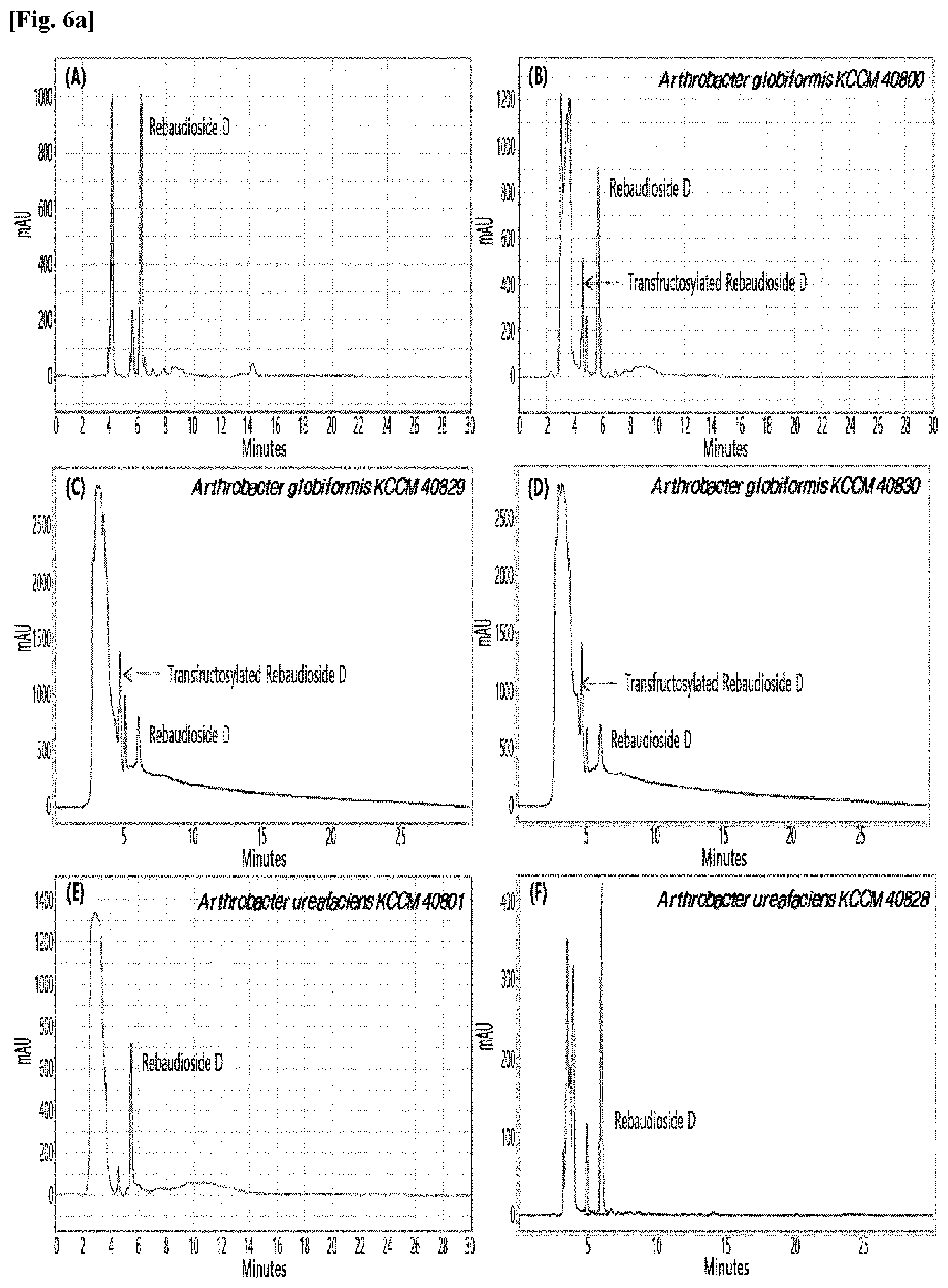
D00012
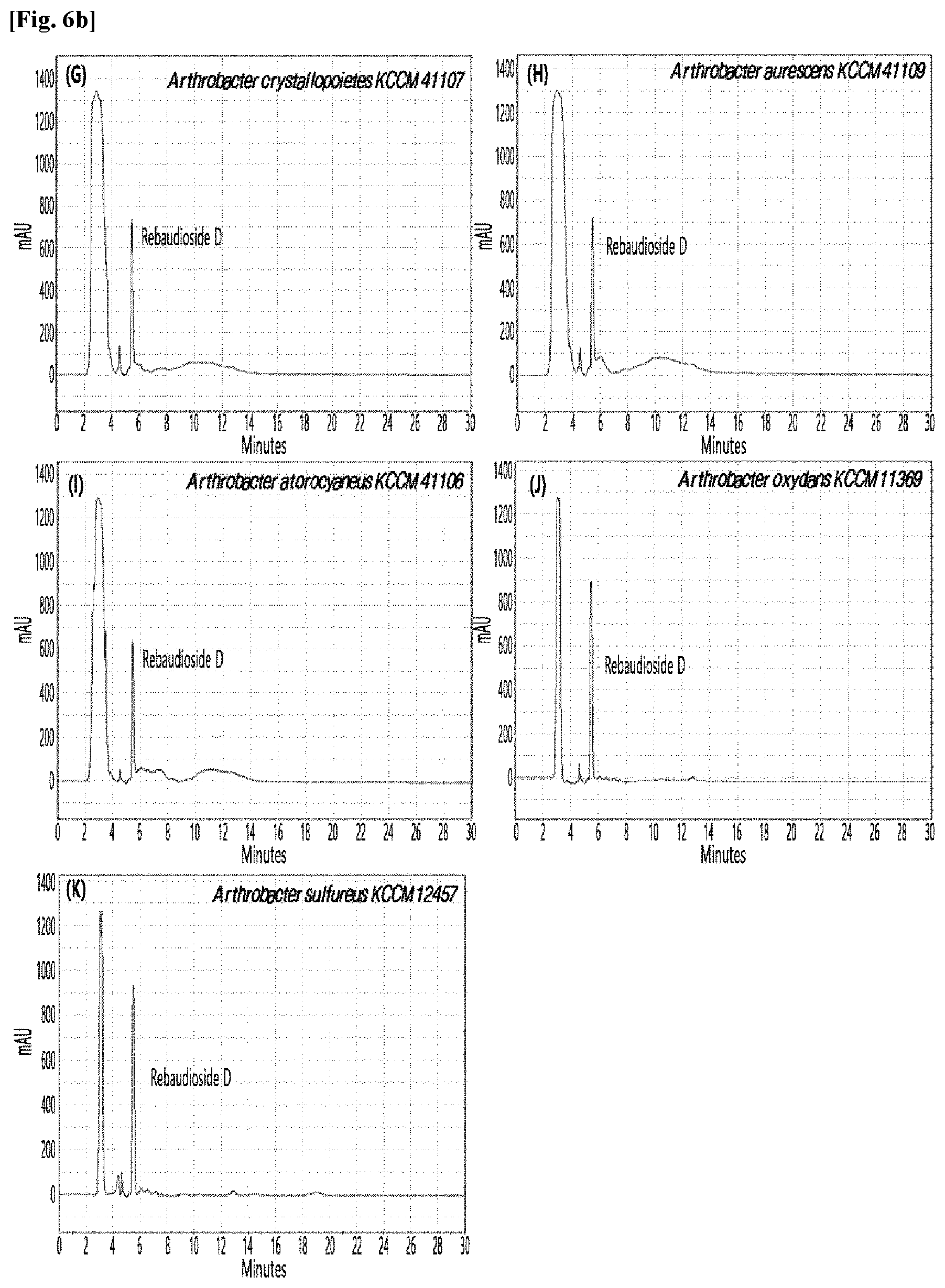
D00013
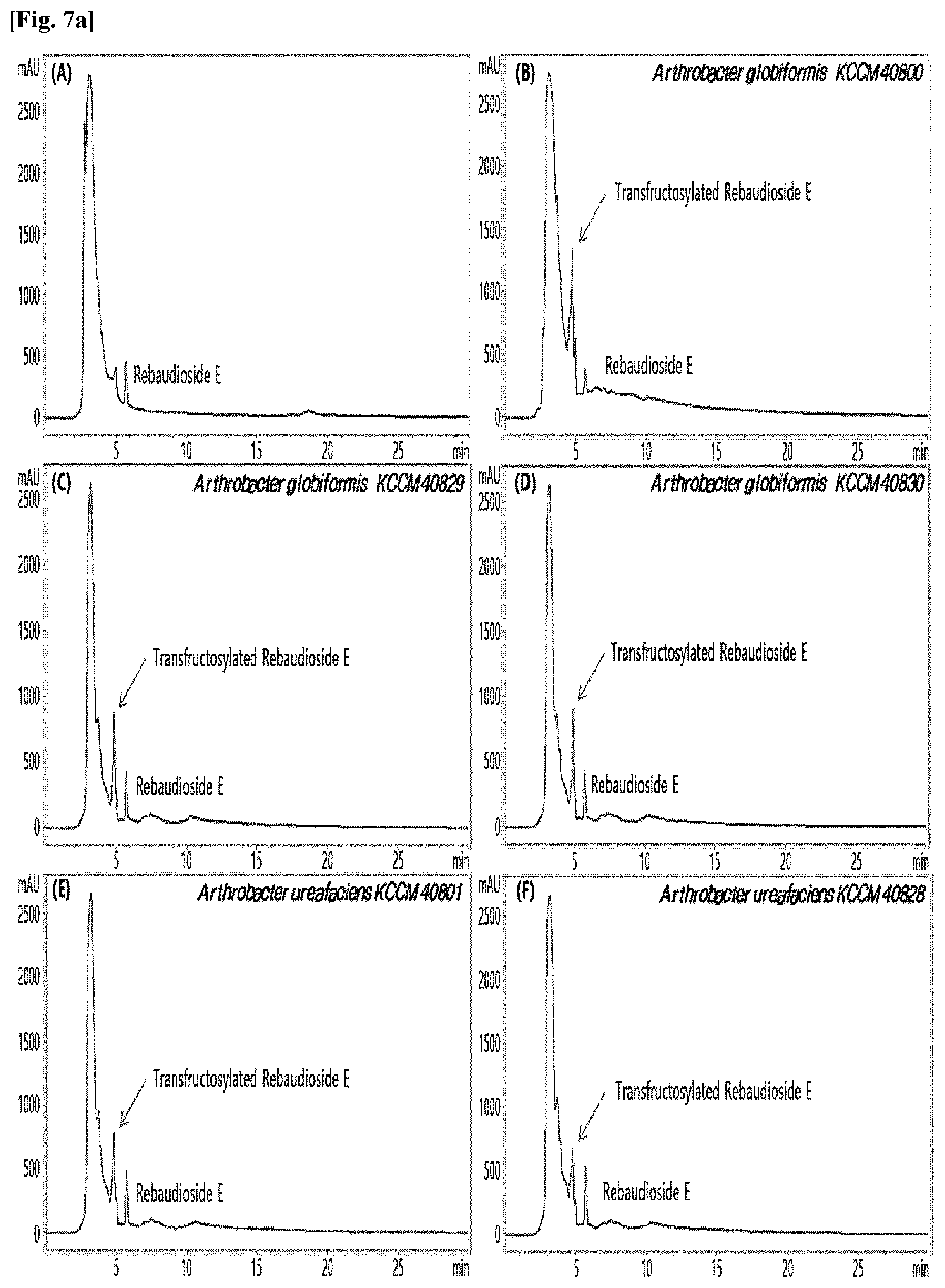
D00014
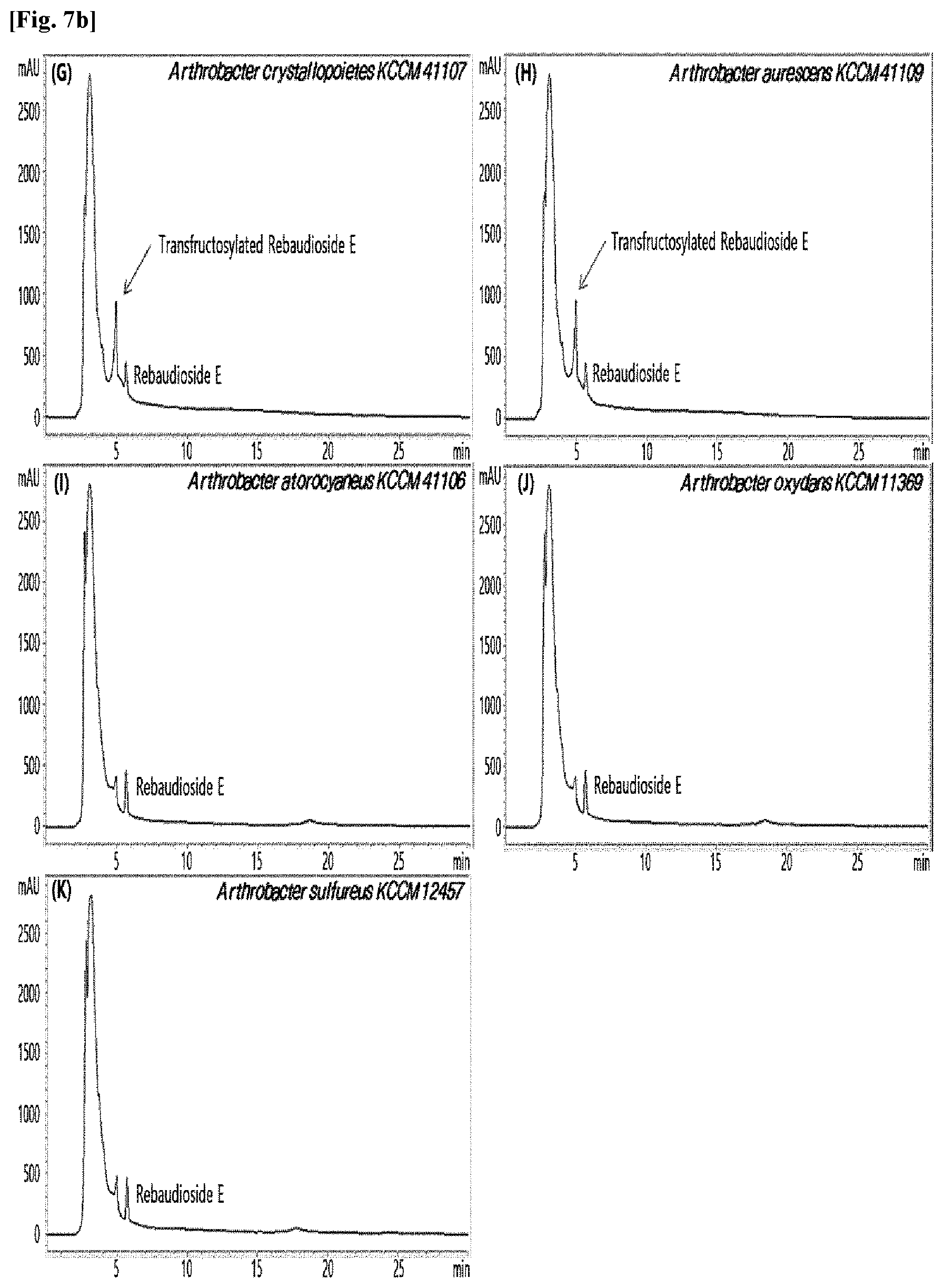
D00015
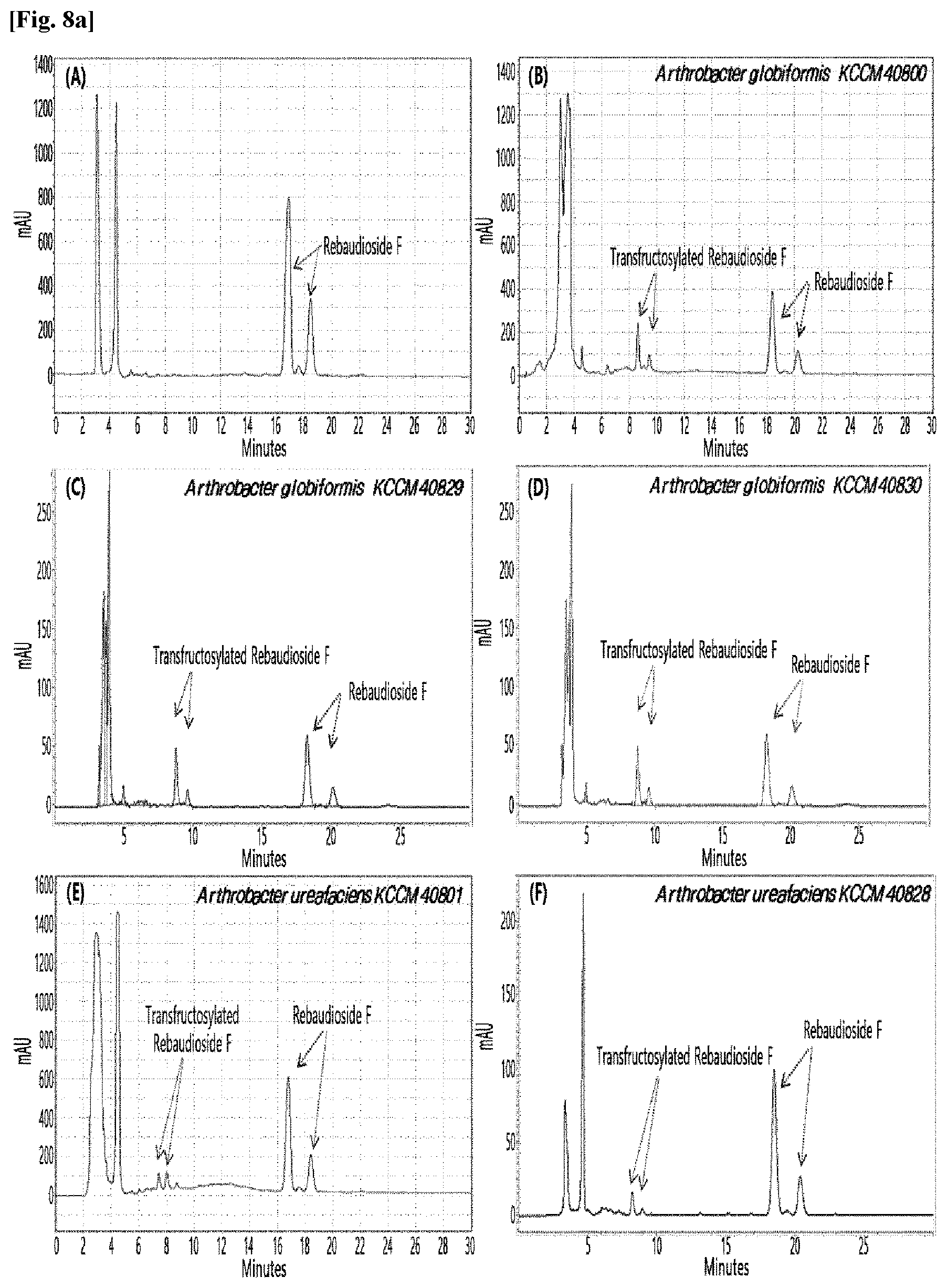
D00016
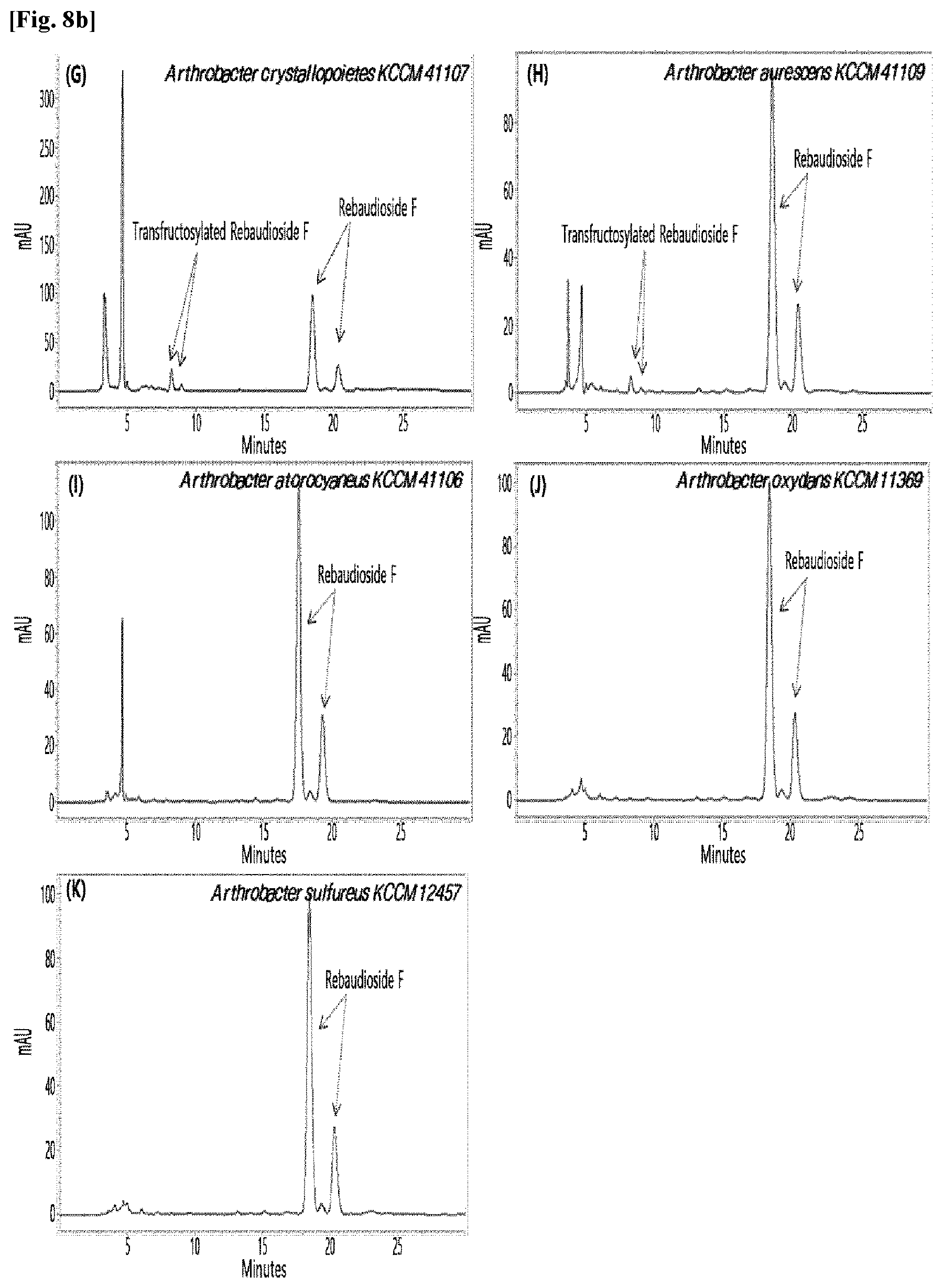
D00017
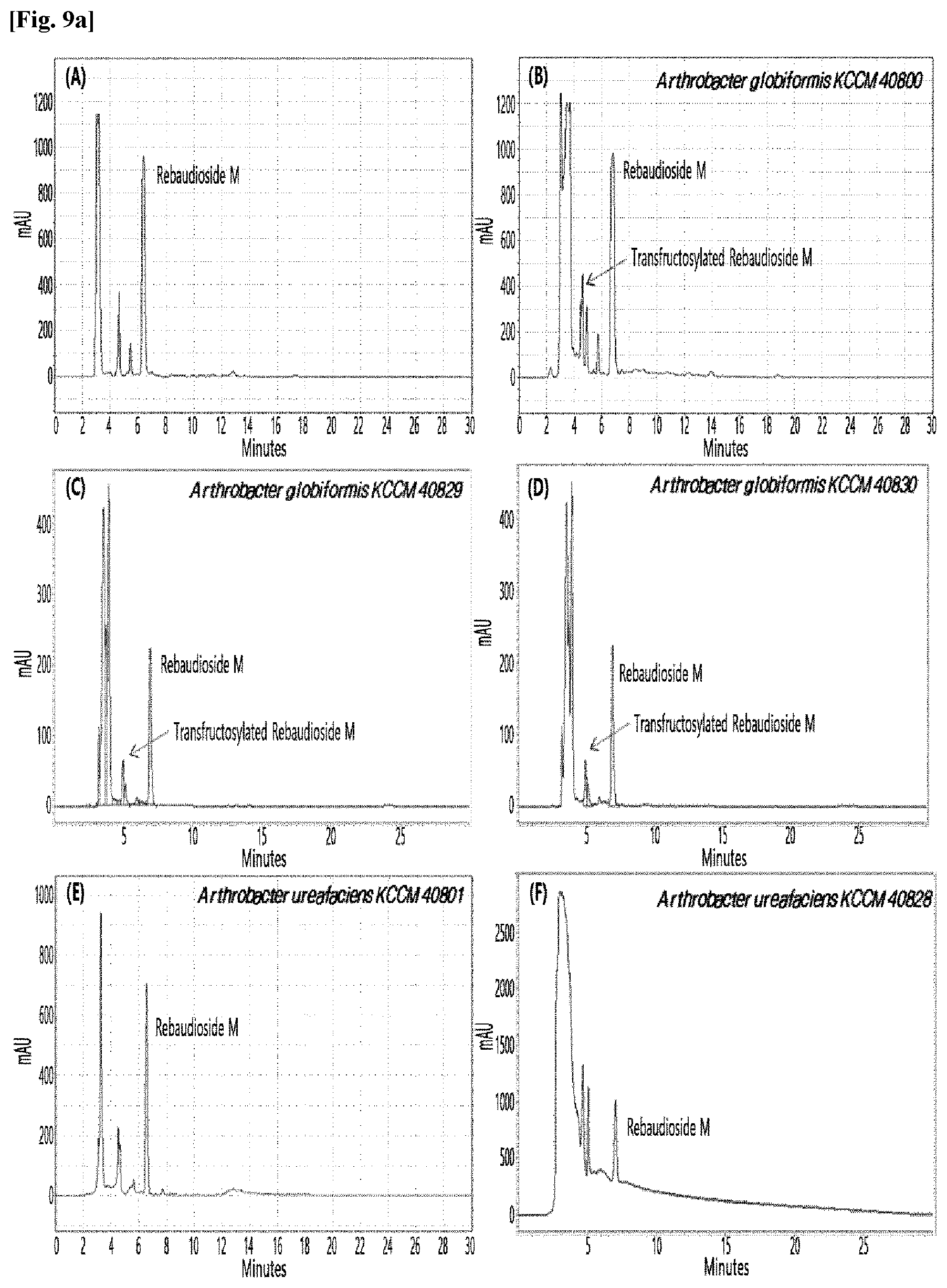
D00018
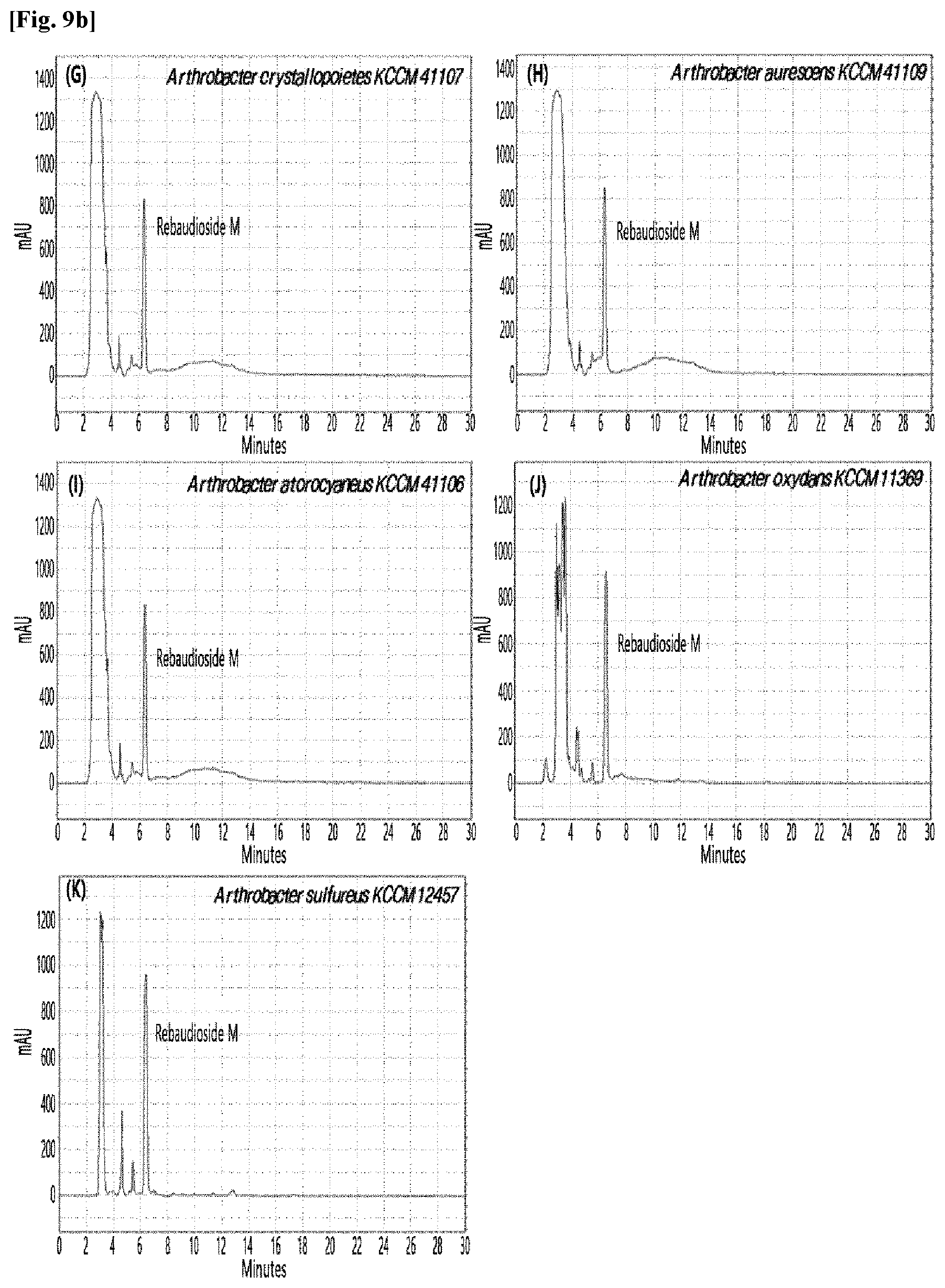
D00019
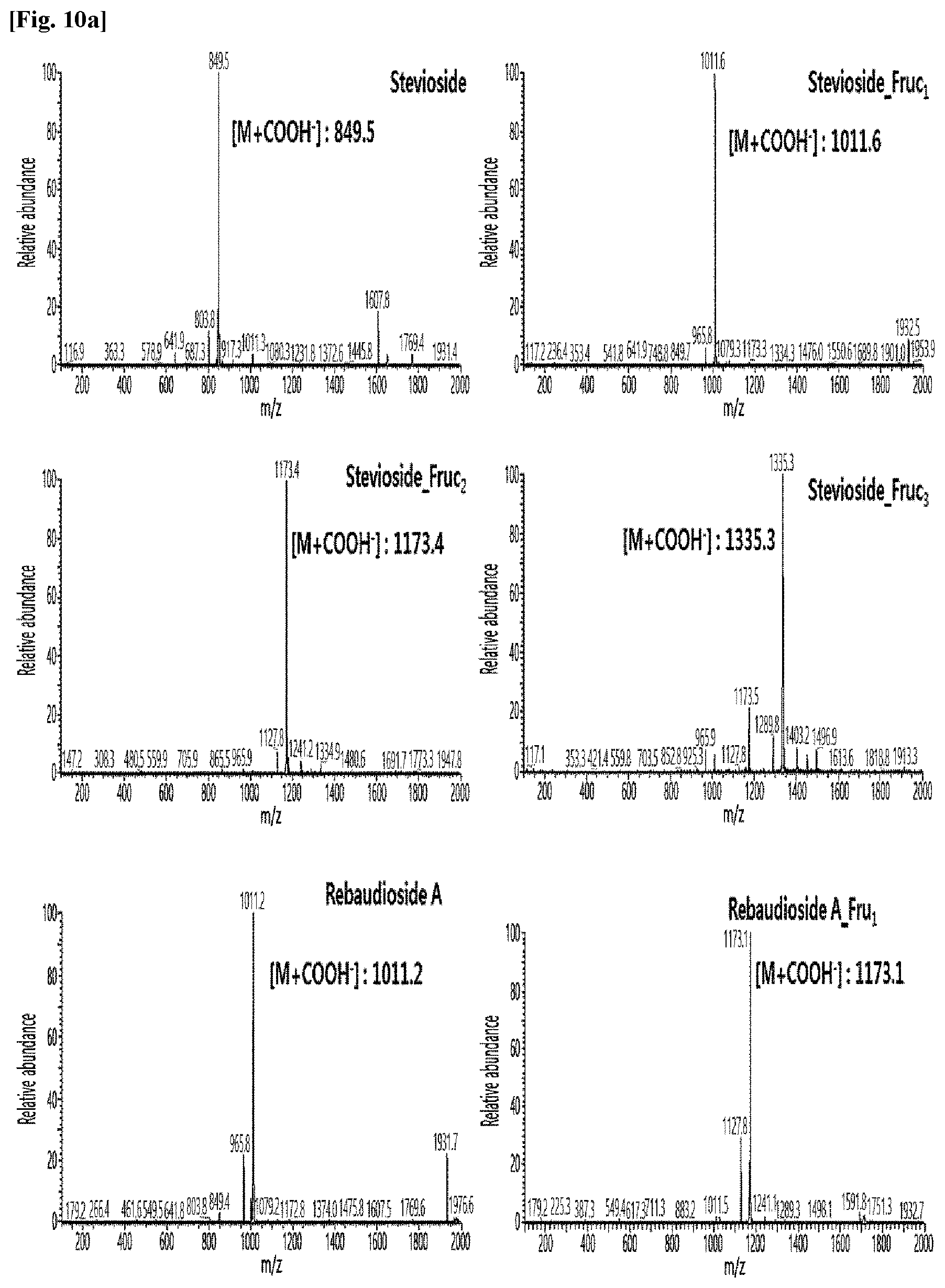
D00020
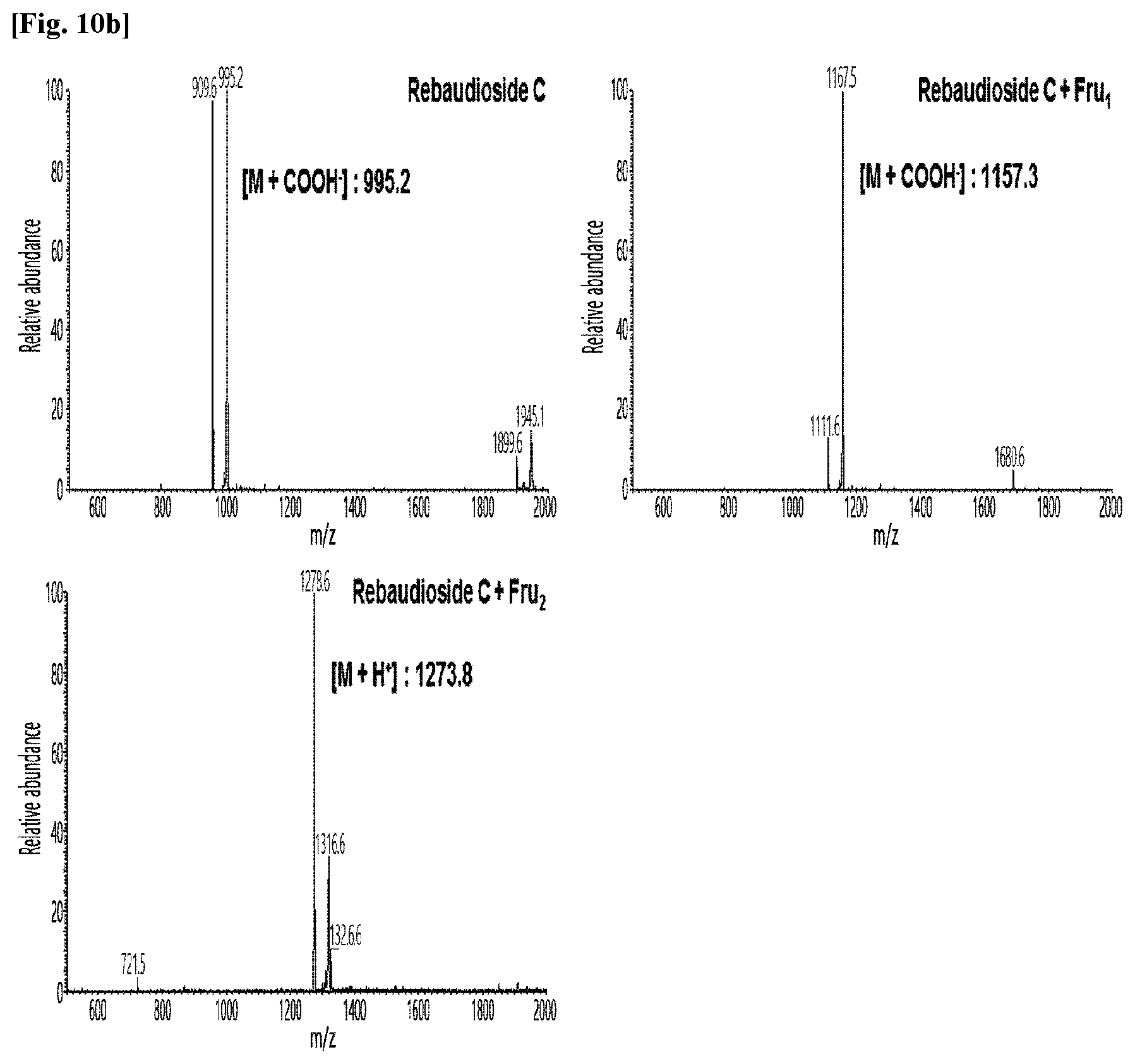
D00021
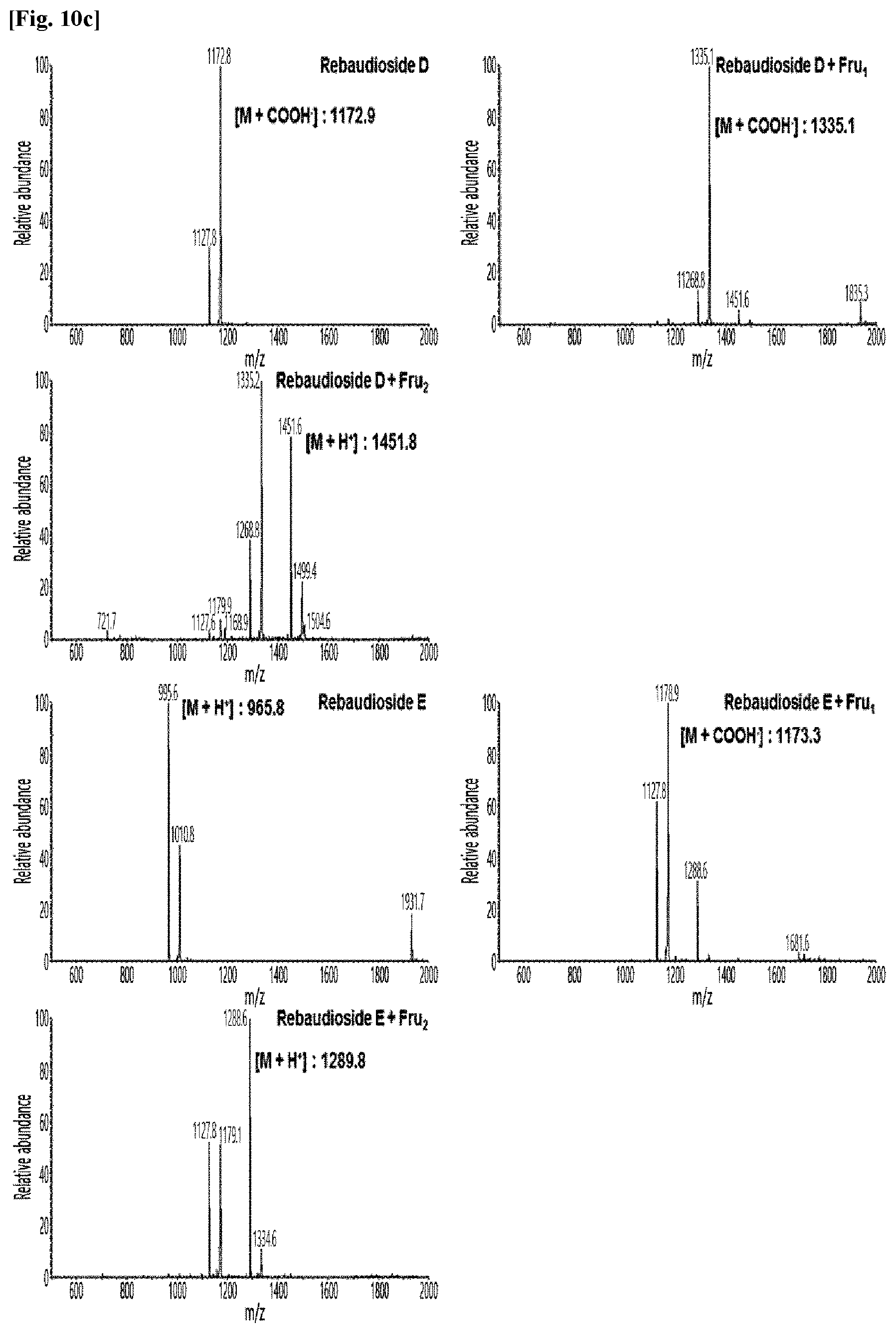
D00022
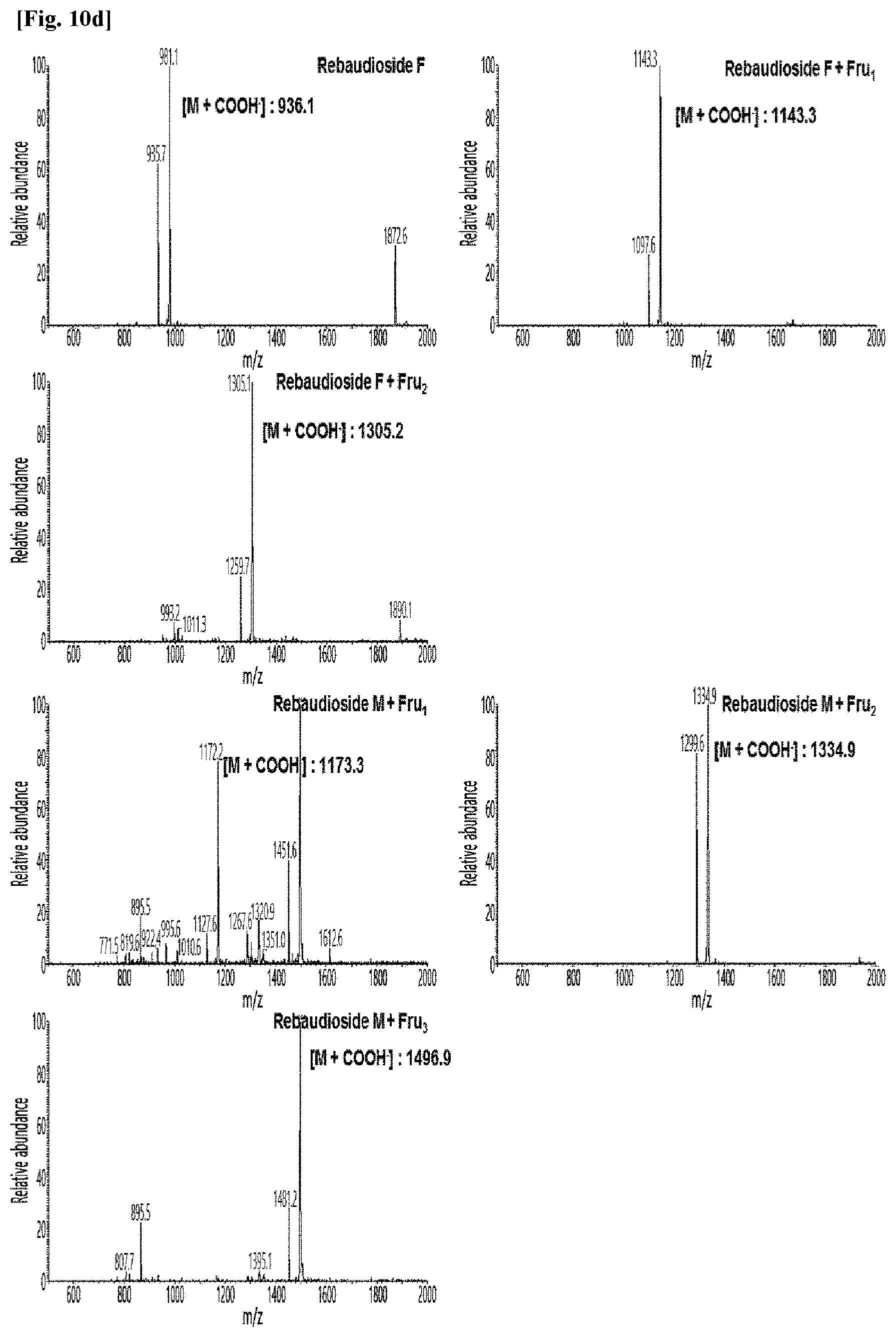
D00023
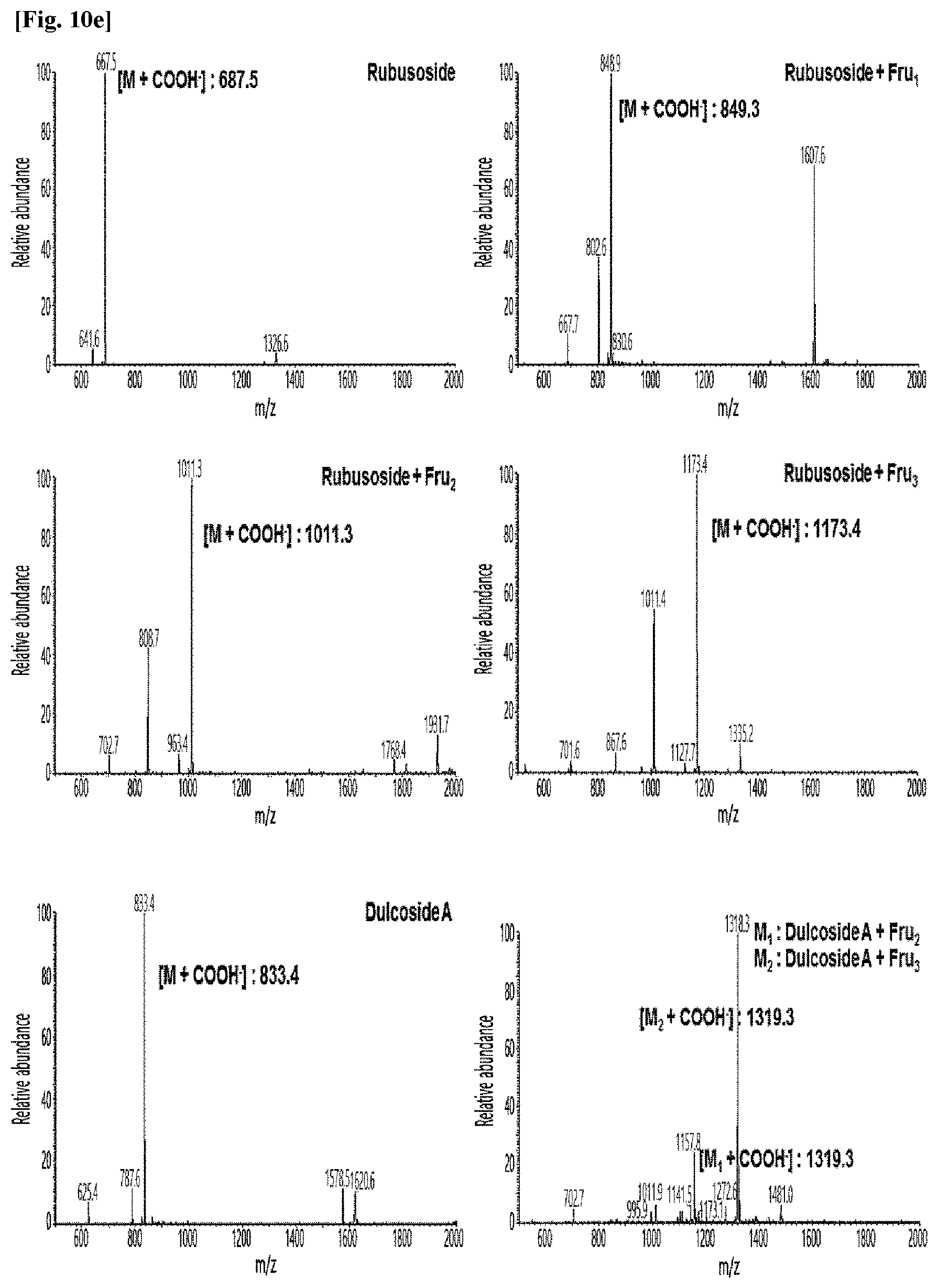
D00024
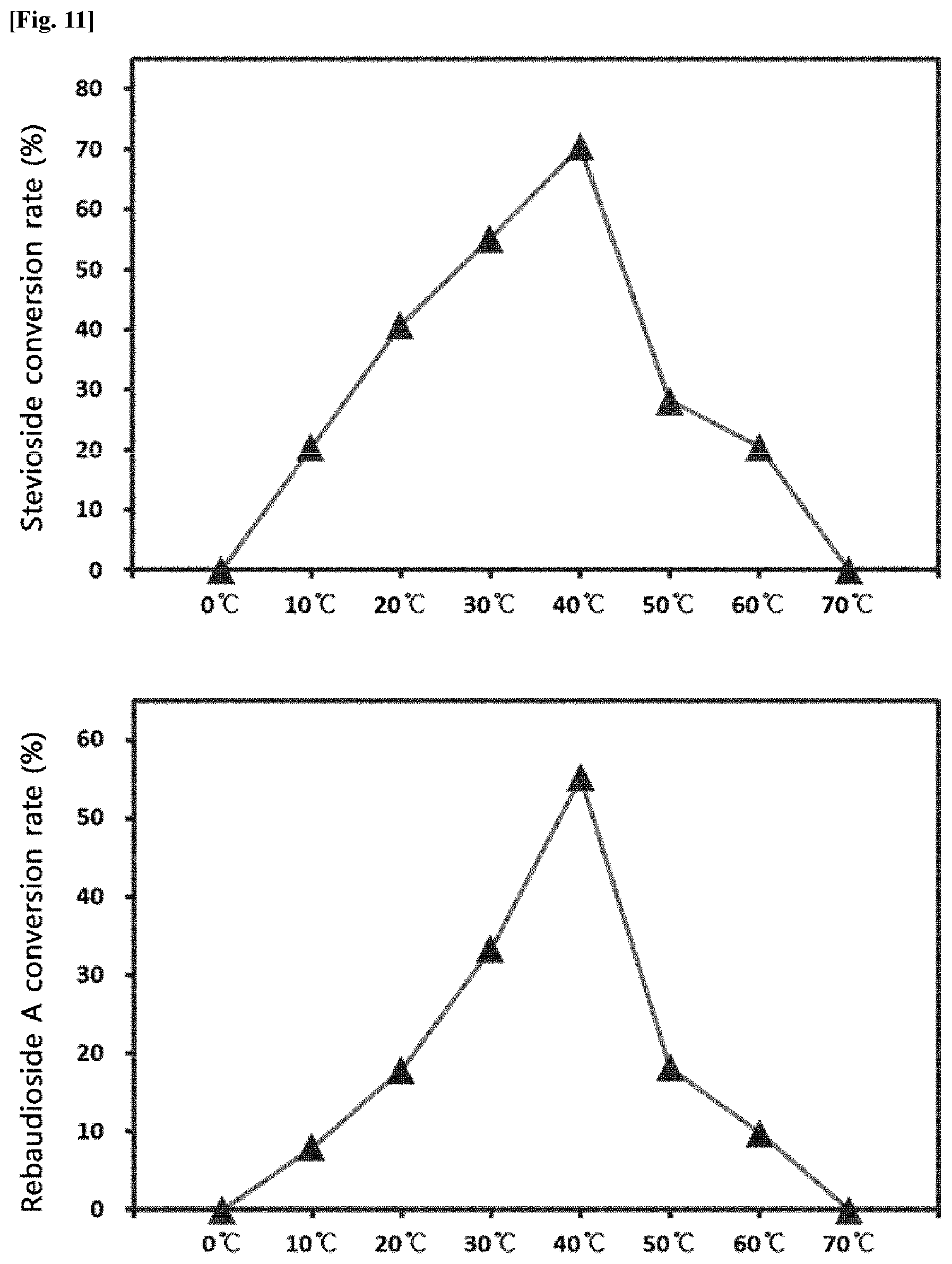
D00025
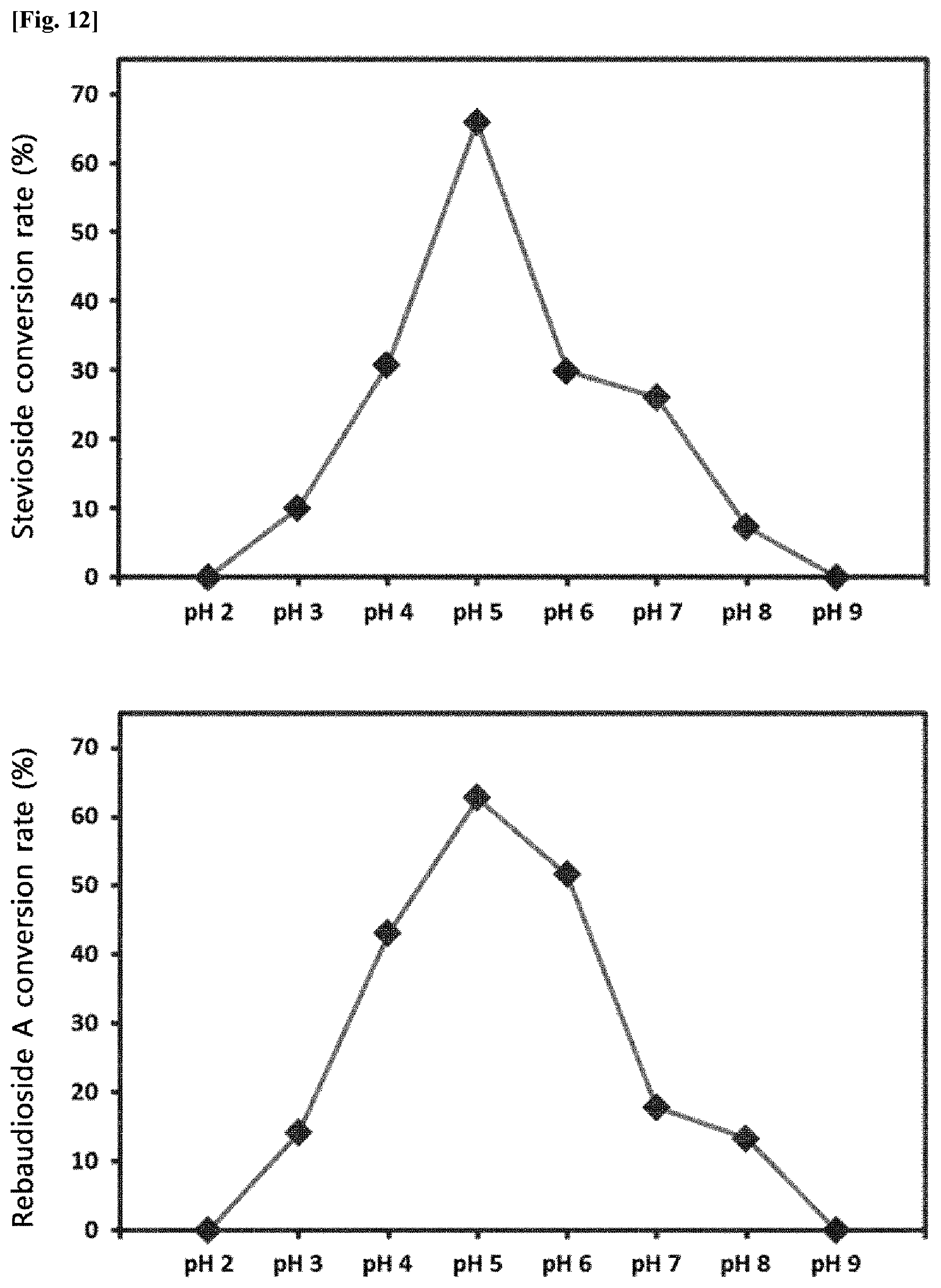
D00026
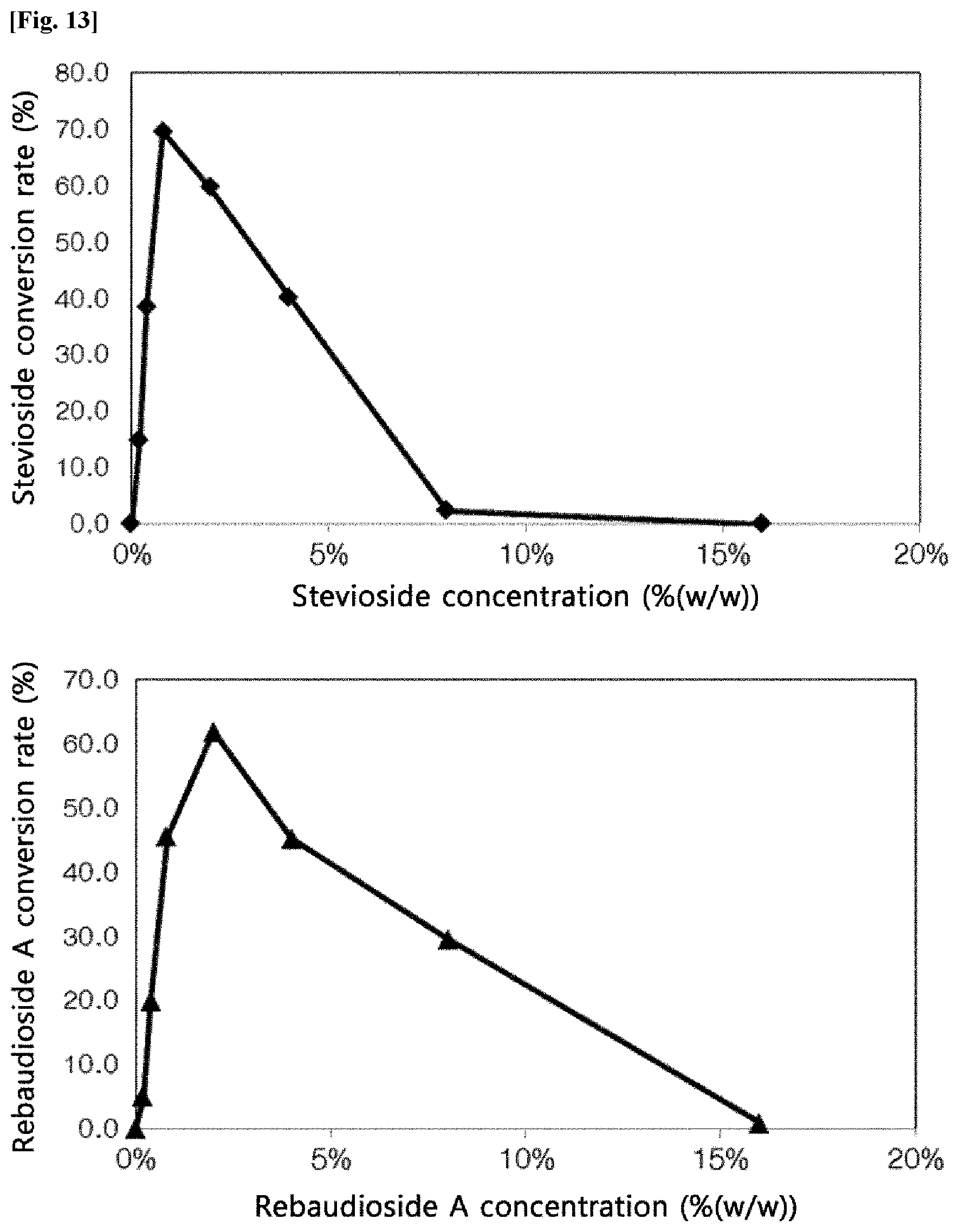
S00001
XML
uspto.report is an independent third-party trademark research tool that is not affiliated, endorsed, or sponsored by the United States Patent and Trademark Office (USPTO) or any other governmental organization. The information provided by uspto.report is based on publicly available data at the time of writing and is intended for informational purposes only.
While we strive to provide accurate and up-to-date information, we do not guarantee the accuracy, completeness, reliability, or suitability of the information displayed on this site. The use of this site is at your own risk. Any reliance you place on such information is therefore strictly at your own risk.
All official trademark data, including owner information, should be verified by visiting the official USPTO website at www.uspto.gov. This site is not intended to replace professional legal advice and should not be used as a substitute for consulting with a legal professional who is knowledgeable about trademark law.